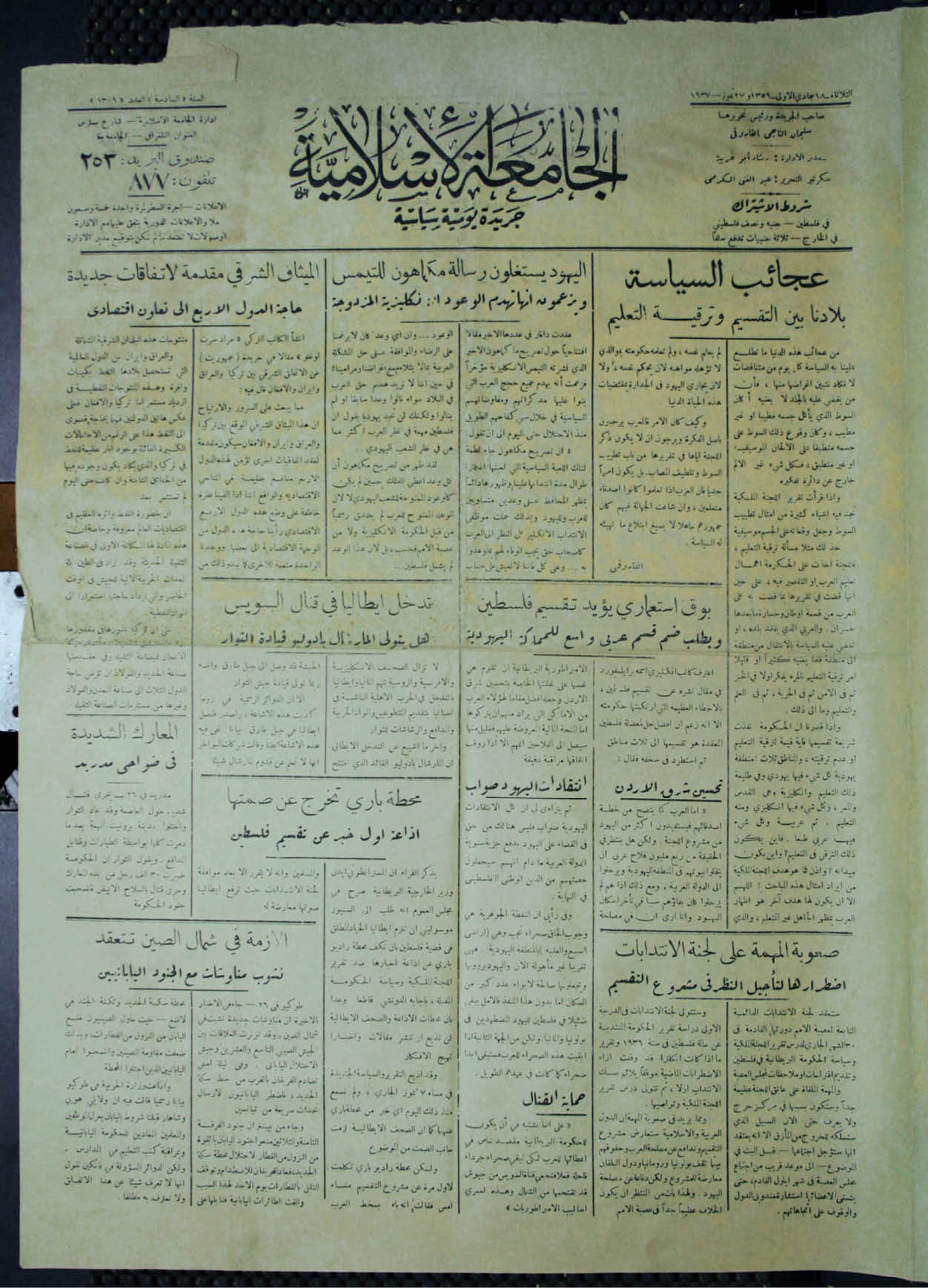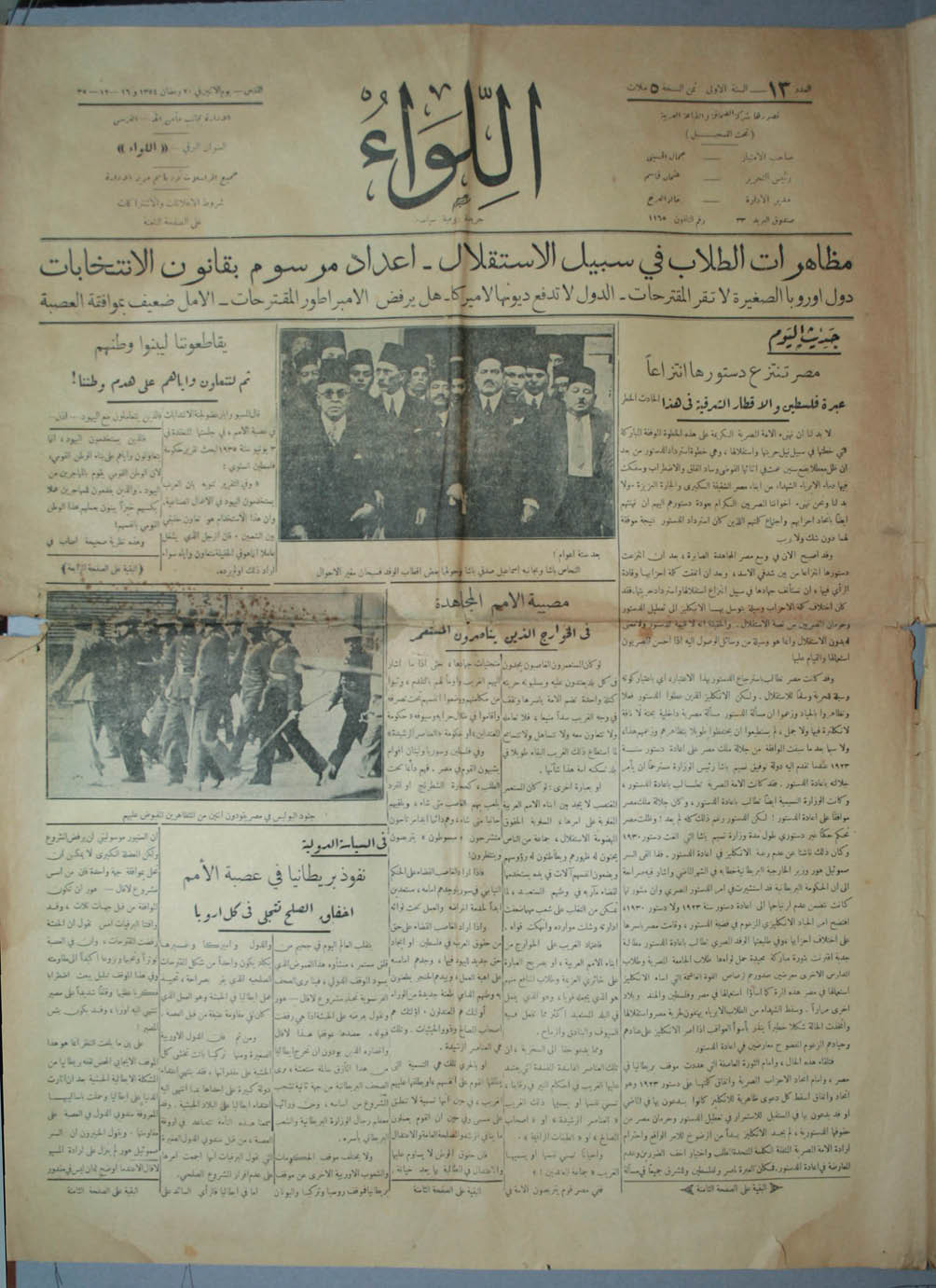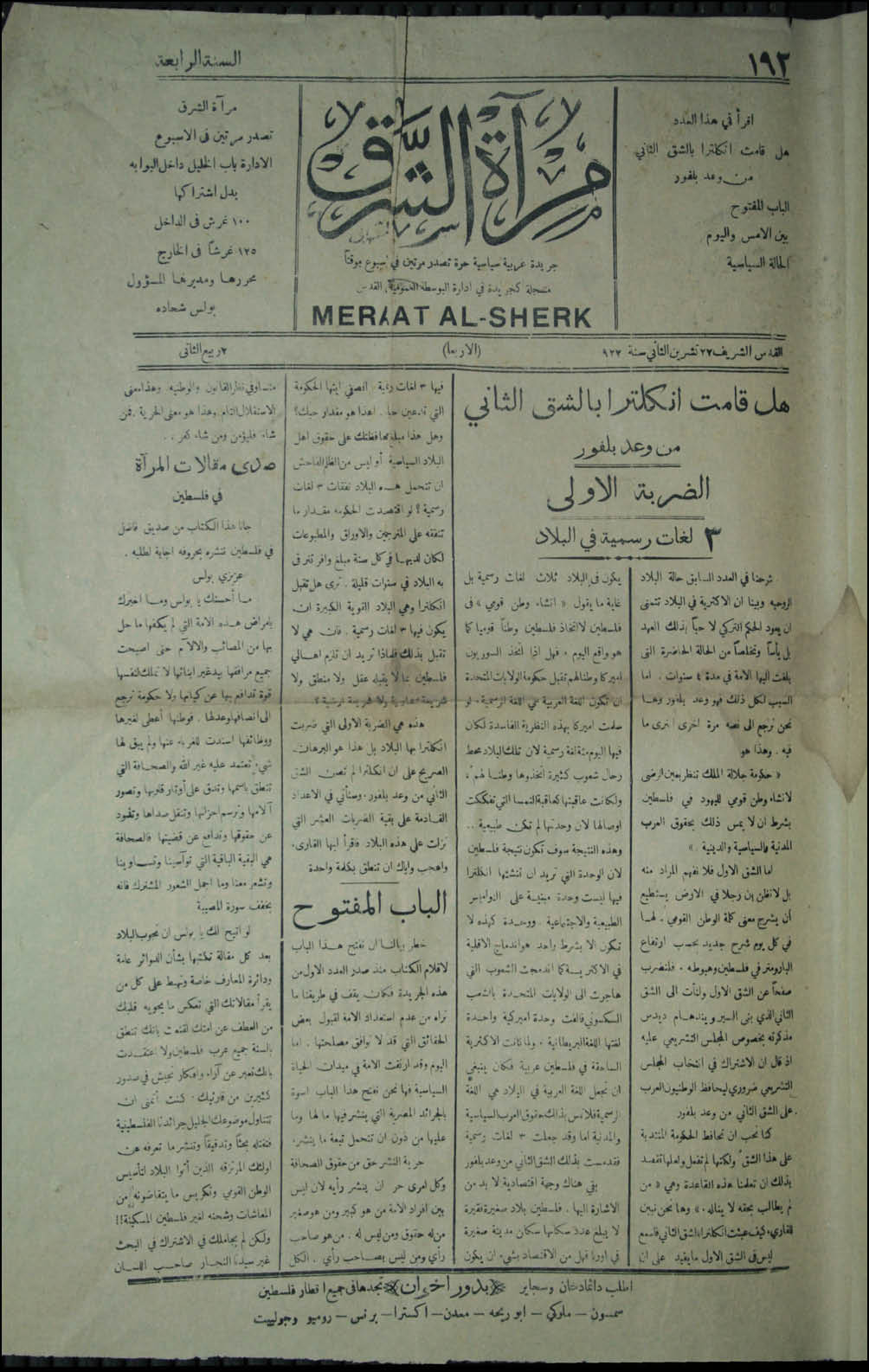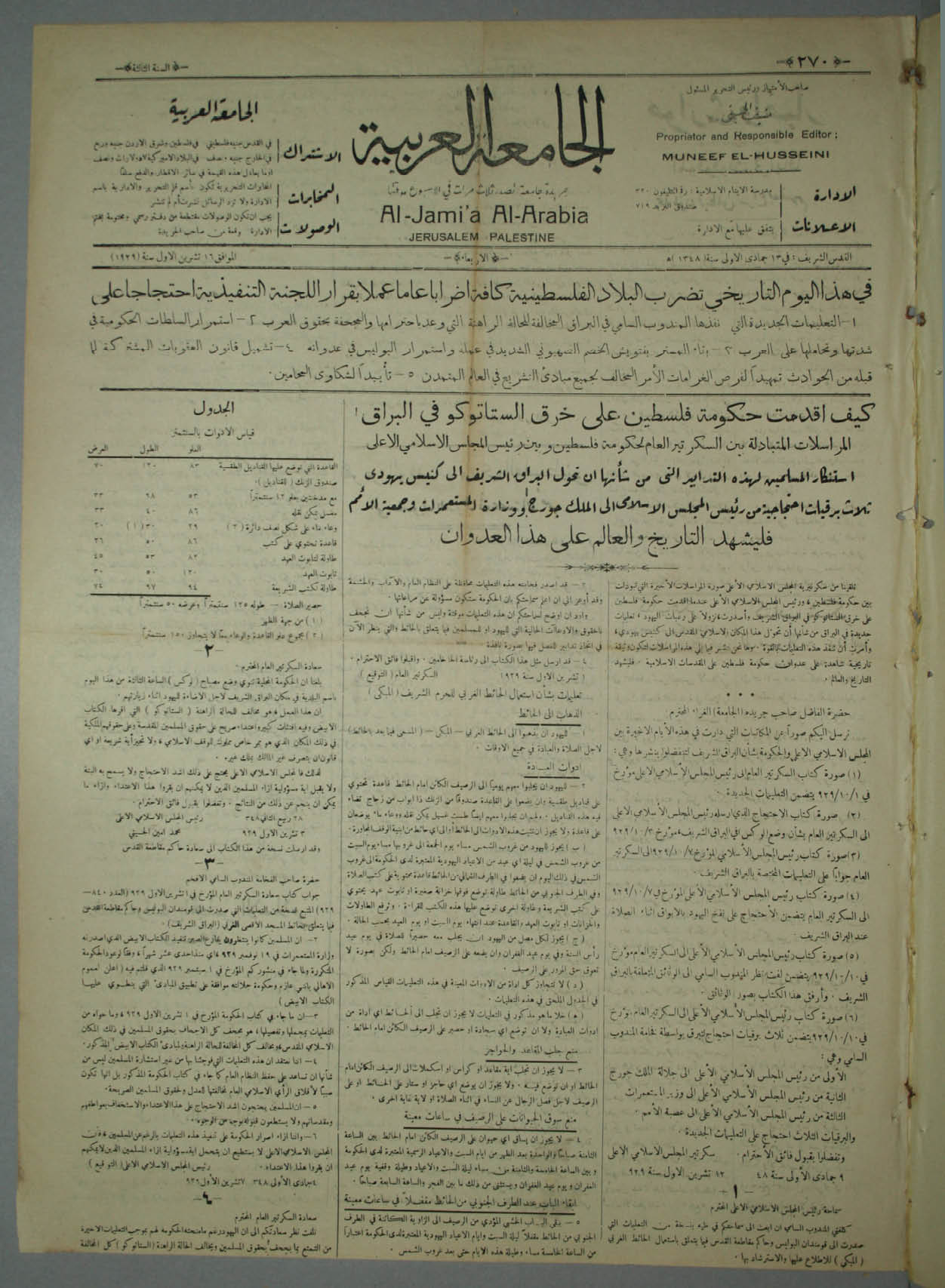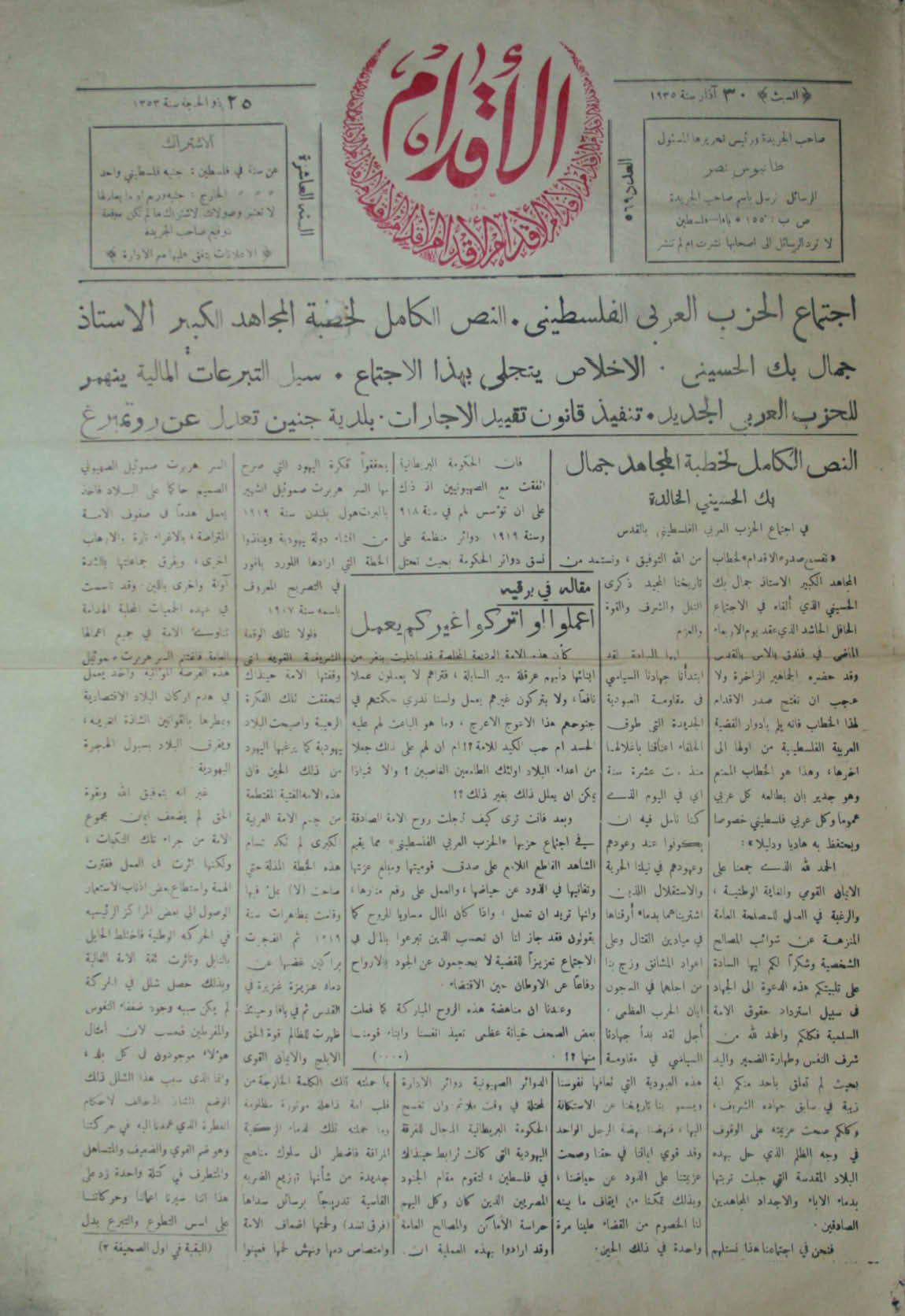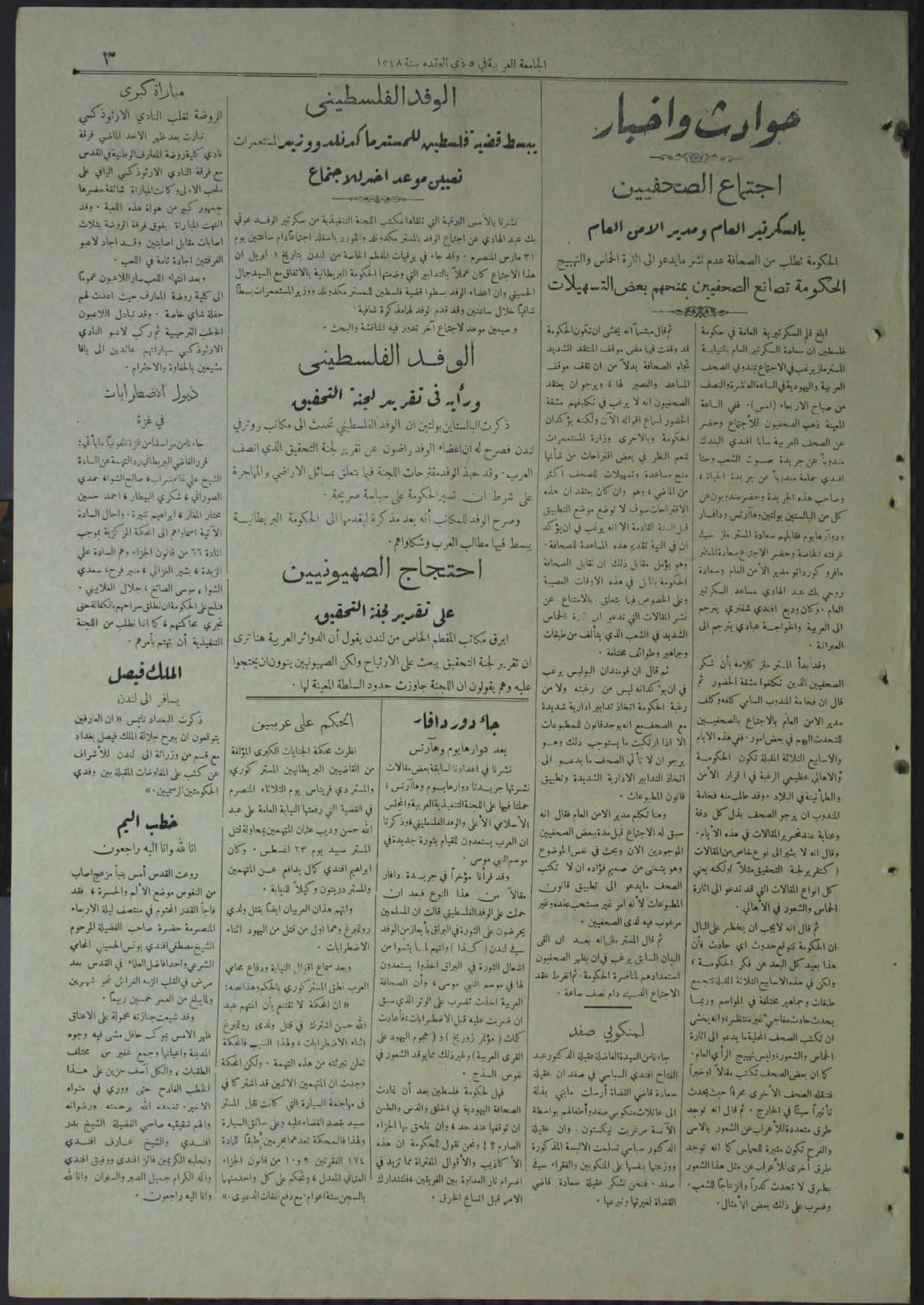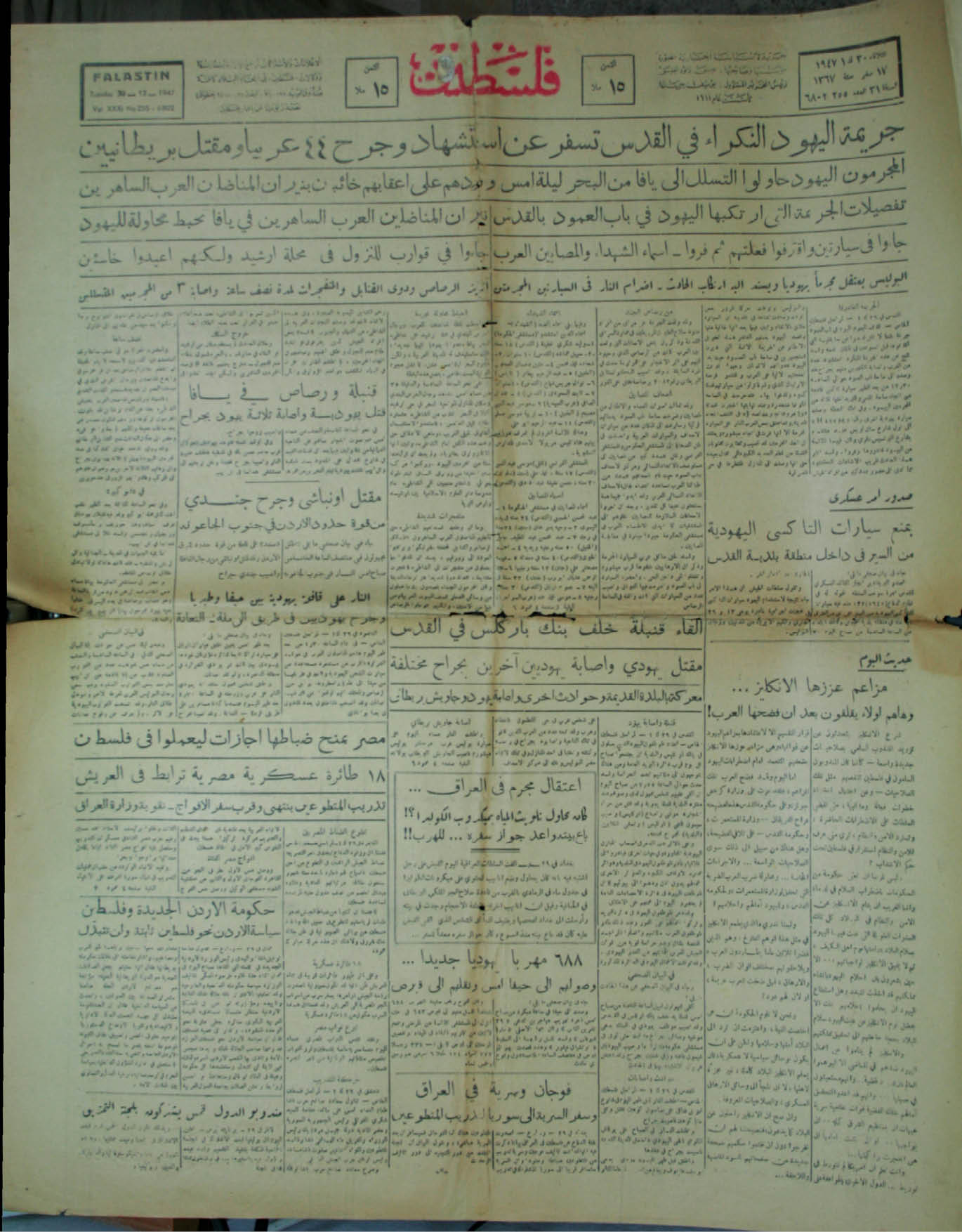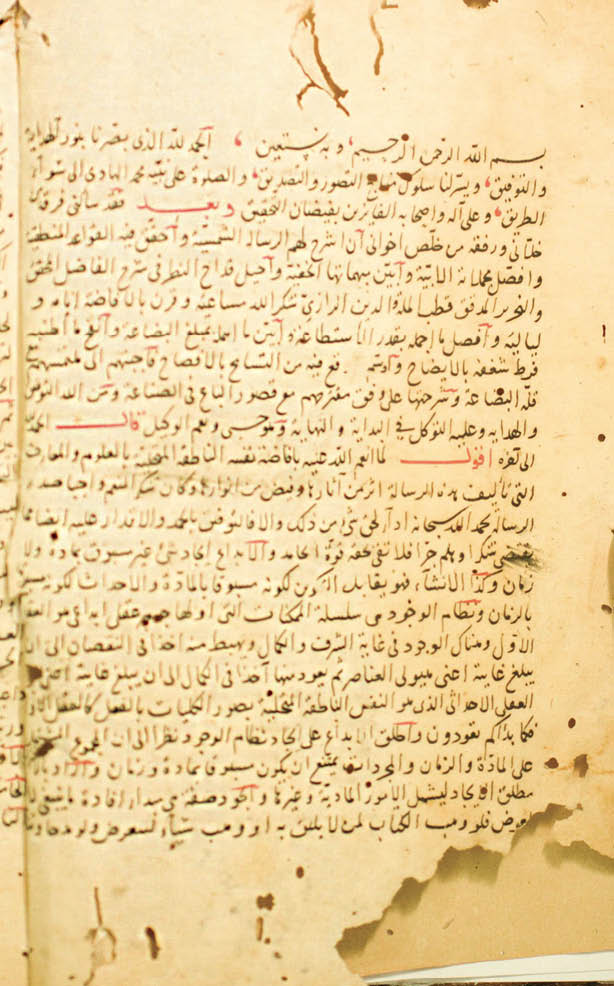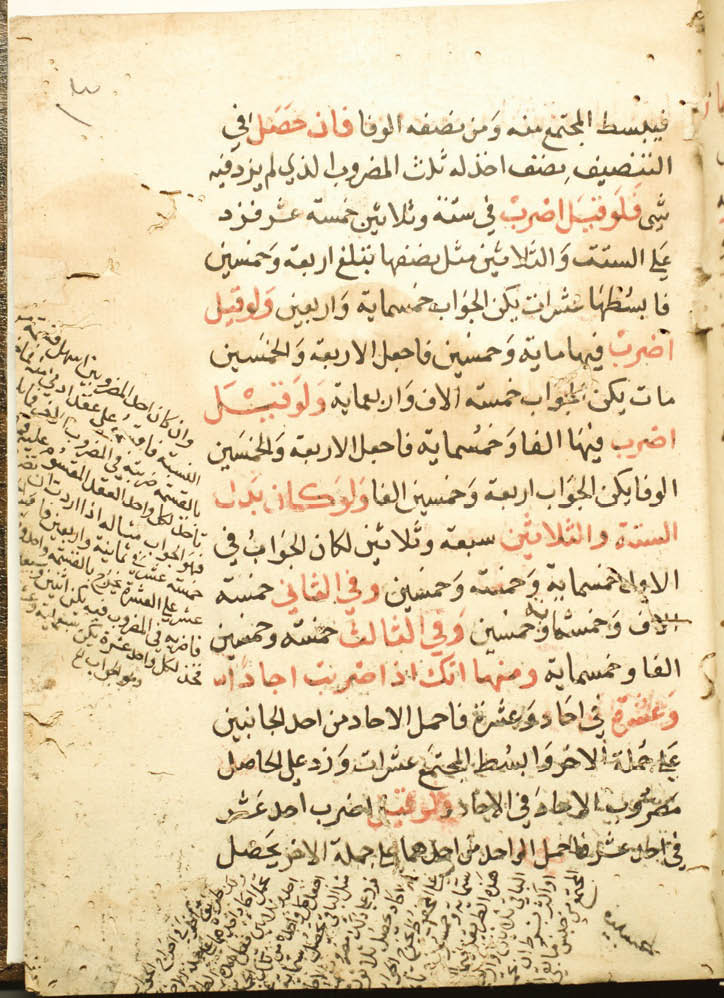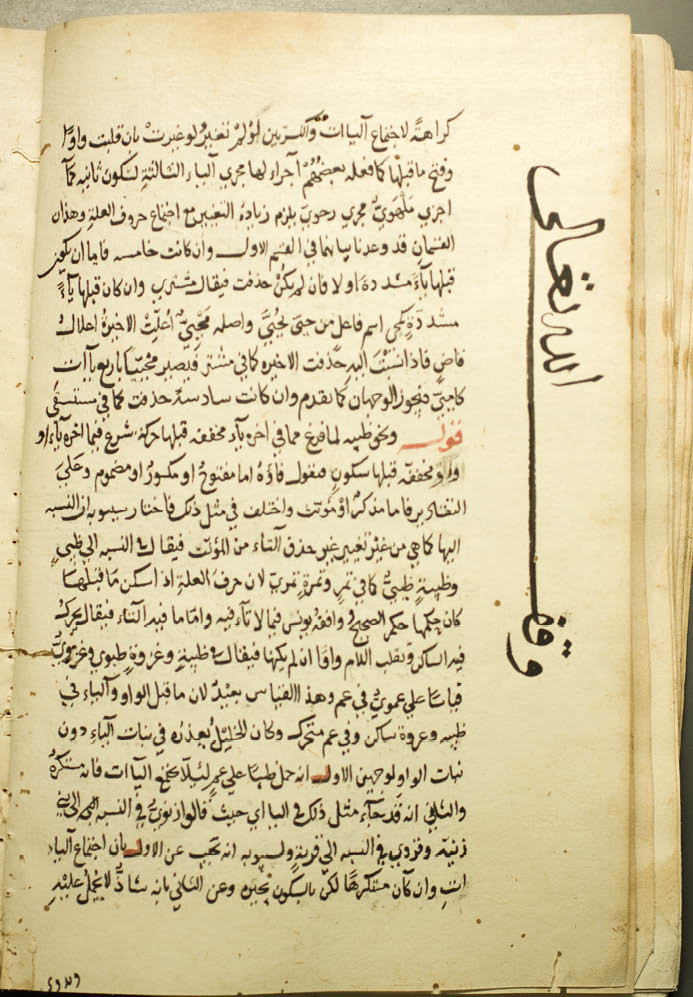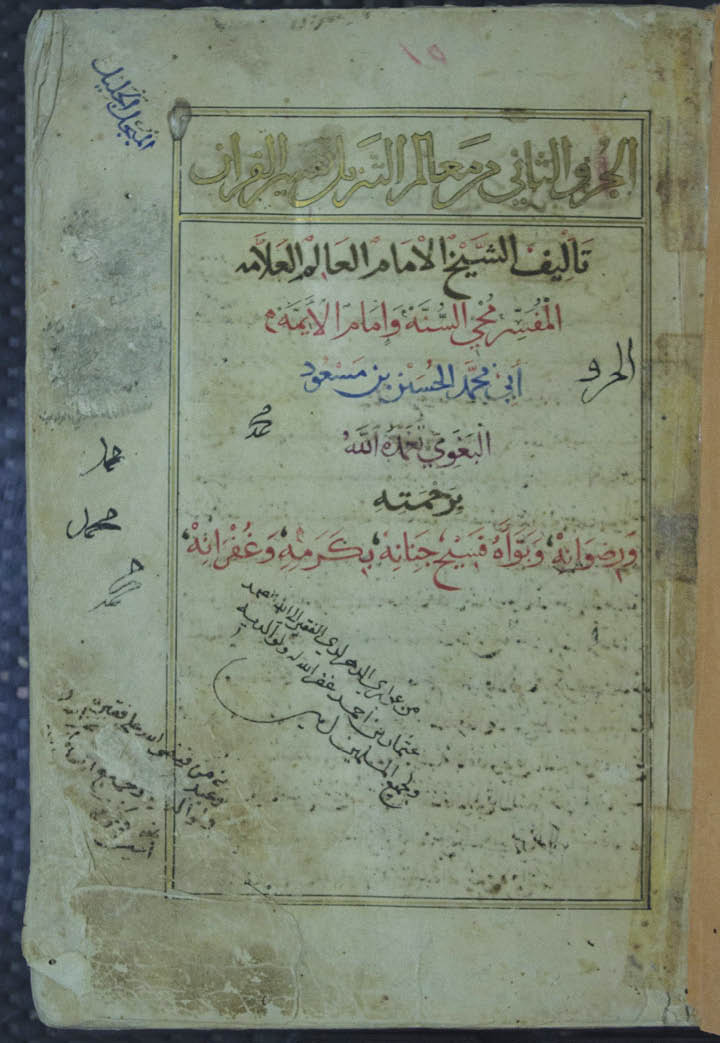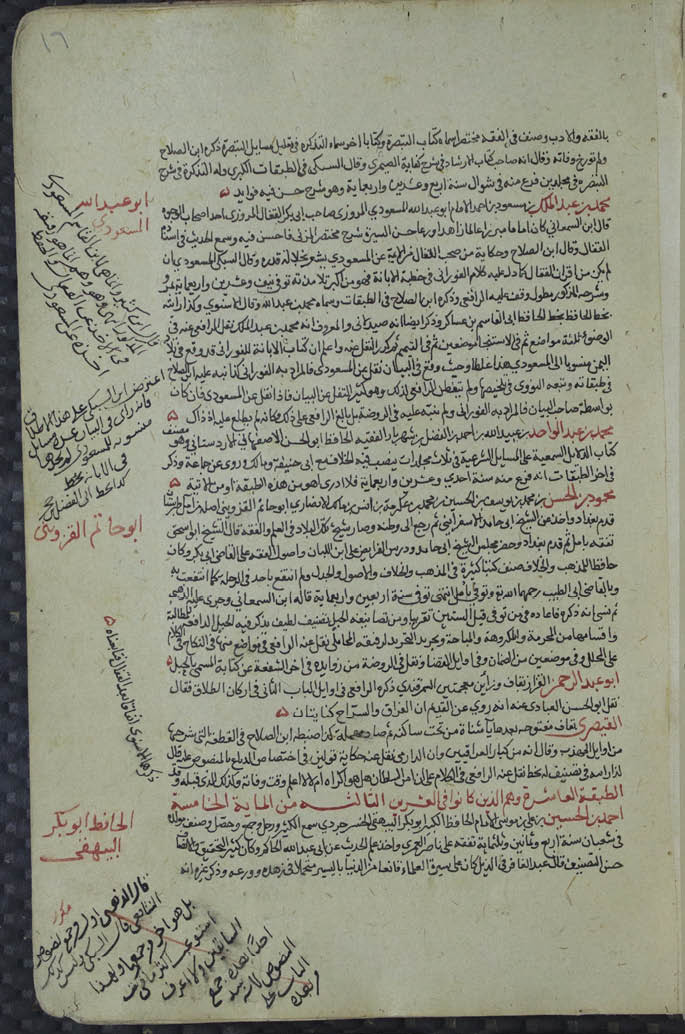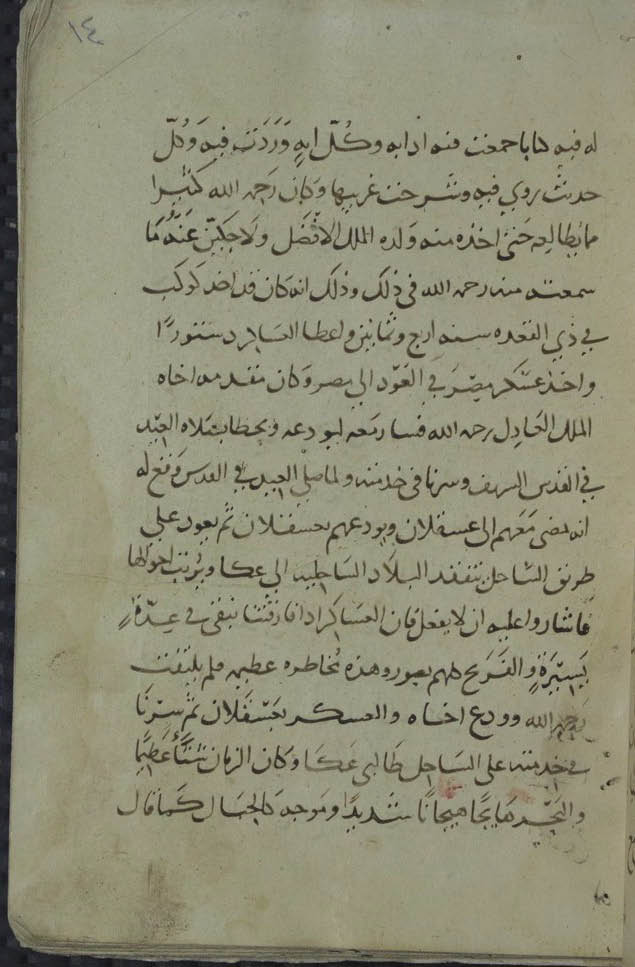12. Digitisation of Islamic manuscripts and periodicals in Jerusalem and Acre1
© Qasem Abu Harb, CC BY http://dx.doi.org/10.11647/OBP.0052.12
This chapter provides an overview of three digitisation projects supported by the Endangered Archives Programme (EAP). The first, EAP119, digitised the collection of historical periodicals in al-Aqṣá Mosque Library in Jerusalem (Al-Quds) in 2007.2 Two subsequent projects recorded manuscripts in al-Jazzār Mosque Library in Acre (ʿAkkā) (EAP399 in 2010) and al-Aqṣá Mosque Library in Jerusalem (EAP521 in 2012).3 After tracing a short history of the two libraries and outlining the development of the early Arabic press in Palestine, this contribution makes the case for the urgency of digitisation and provides a brief account of the digitisation process along with the challenges that the projects had to overcome.
The Mosque Libraries of al-Aqṣá in Jerusalem and al-Jazzār in Acre
In Islam, books and book collections have always been seen as a mark of faith, learning and wisdom that lent prestige to their owners. Islamic rulers sought to outdo their predecessors by founding libraries with vast collections of magnificent quality, whilst mosques and madrasahs created impressive book collections in order to enhance their reputation as centres of learning, and scholars achieved fame for their private libraries.4 The late Ottoman Palestine was no different: the mosques and Muslim courthouses contained collections of religious literature and many large private collections were held in the city homes of distinguished families.5
The older of the two libraries where the digitisation projects supported by the EAP took place is located in the northern city of Acre. Al-Jazzār Mosque Library (al-Aḥmadīyah) is a part of a waqf, a pious foundation of Ahmad al-Jazzār, the eighteenth-century Ottoman governor (pasha) of the provinces of Acre. Al-Jazzār’s waqf was the largest such endowment in the history of Acre. It was the only waqf in this city which was publicly administered under the Ottoman Ministry of Waqf and later, during the British Mandate rule, under the Supreme Muslim Council.
The waqf was created in May 1786 and the endowment included: a mosque, Jami al-Anwar, “the Mosque of Lights”, an Islamic college with fifty rooms for the lodgings for students from the four schools of Islamic law, a large library, a public fountain, an underground water reservoir, a ritual bath, a sundial, a garden and 29 stores surrounding the mosque courtyard.6 The mosque and adjacent buildings, which were heavily damaged by Napoleon’s bombardment in 1799, underwent renovations in the early nineteenth century.7 Throughout the rest of the century the library attracted many visitors, not only from the Muslim community since — unlike in the case of other mosques — Christians were allowed to enter al-Jazzār Mosque and adjacent buildings.8
Al-Jazzār Mosque was one of the many buildings damaged by the Egyptian bombardment of Acre in 1831-1832. The mosque’s library was looted and the Egyptian army used the yard as a camp.9 After the defeat of the Egyptians and the liberation of the city, the library was re-opened and remains open to this day.
The newer of the libraries, al-Aqṣá, is located at the heart of the Old City of Jerusalem, in the southwestern corner of the al-Haram al-Sharif (Noble Sanctuary) complex. Founded in 1922 by the Supreme Muslim Council in Palestine under the leadership of the mufti of Palestine, Hajj Amin al-Husseini, the library brought together the books that had been kept in al-Aqṣá and the Dome of the Rock buildings, and gradually also acquired books from private libraries in Jerusalem, in Palestine and even from abroad.10 In 1923, Adel Jabre became the first director of al-Aqṣá Library and, at the same time, the director of the Islamic Museum. The al-Aqṣá archive preserves his correspondence with the intellectuals in the Middle East and Europe he approached for book donations.11 The uniquely revered status of al-Aqṣá had brought it endowments of private book collections and book gifts, including publications on modern science and literature and donations of local journals.12
Al-Aqṣá Library was first housed in Qubbat al-Nahwiyyah, a building that lies in the southwestern corner of the Haram al-Sharif compound and was once home to a thirteen-century school of literature. The library was subsequently moved to the sacred compound, and the manuscripts were stored in a building nearby.13 The development of the library was also stifled by the events of 1948 and their aftermath, when Palestinian libraries were closed, suspended or had their holdings divided among other institutions. Between May 1948 and the end of February 1949, the staff of the National Library of Israel and the Hebrew University of Jerusalem Library collected some 30,000 books and manuscripts that had been left behind by the Palestinian residents of western Jerusalem.14 Of these, about 24,000 were disposed of because they were considered irrelevant or hostile material.15 The remaining 6000 books have not been returned, despite a clear statement by the 1954 Hague Convention for the Preservation of Cultural Property, and despite the fact that the National Library of Israel — an internationally leading cultural institution and the recipient of many books stolen in the Holocaust — is well-placed to recognise the importance of acts of restorative justice.16
After a long period of inactivity from 1948 to 1976, the Waqf Administration decided to revive the library in early 1977. The library’s collection was moved from the Islamic Museum to the ground floor of the monumental fifteenth-century Ashrafiyya madrasa.17 In 2000, the library was relocated again to its current position, the building of “Jami‘ al-Nisa”, or “Women’s Mosque”, between al-Aqṣá Mosque on the east side and the Islamic Museum on the west.18 The most valuable part of the library’s collection consists of approximately 2,000 manuscripts and 74 historical Arabic newspapers and magazines titles from the region.19
The urgency of digitisation
The digitisation of the holdings of al-Aqṣá Mosque Library and al-Jazzār Mosque Library was urgently needed in order to document the collection and preserve its content. The manuscripts and the newspapers have been deteriorating rapidly due to the poor environmental conditions in libraries which lack proper humidity and temperature control. The lack of a preservation programme, and the shortage of staff trained in conservation and preservation methods were also a serious threats.20 This issue has now been addressed by the joint project of UNESCO and the Waqf, Jordan’s Islamic authority, initiated in 2014 to restore al-Aqṣá Library’s manuscripts, old maps, Ottoman population and trade registers and hand-written documents from the Mamluk period.21
The fragile condition of the documents has been aggravated by scholars and students handling the materials.22 Moreover, because of the unstable political situation in Jerusalem, the location of al-Aqṣá Library in the Old City presents not only a significant threat to the collection, but also makes access difficult. Palestinians from the West Bank or the Gaza Strip have to obtain permits from Israel to enter Jerusalem. Students and scholars are frequently unable to access the library because of the curfews imposed due to political unrest in the Old City.
Consequently, all three digitisation projects supported by the EAP had a dual aim: to help the preservation of the materials by creating digital surrogates, and to facilitate access to the materials and make them available to scholars and students in Palestine and worldwide. Each of the three projects created digital photographs in TIFF format. One set remains in al-Aqṣá Library and al-Jazzār Mosque Library, while another has been transferred to the British Library and made accessible via the Internet to scholars worldwide.23
Digitising the collection of historical periodicals in al-Aqṣá Mosque Library
Al-Aqṣá Library contains more than seventy Arabic language newspaper and journal titles, published in Palestine and other Arab countries as well as a selection of periodicals published by the Arab communities in Europe and North and South America. Copies of the historical Palestinian periodicals and newspapers are extremely rare and for many of the titles, the library holds the only copy available in the region.24
The region’s first privately published journals appeared in Beirut in the third quarter of the nineteenth century. By 1880 new presses opened in Cairo, Alexandria and other Egyptian towns, reaching a total of 627 different newspapers with a circulation of perhaps 100,000 copies by 1908.25 In Palestine, printing was first undertaken by Christian religious institutions, starting with a Franciscan press established in Jerusalem in 1846. The Armenian and Greek churches followed suit, but in all these cases printing was limited to evangelising materials.26 The Arabic periodicals first appeared in Palestine only after the Young Turks rebellion in 1908, when political changes in the Ottoman Empire brought about the abolition of censorship.27 As many as fifteen periodicals appeared in 1908, another twenty were published before the outbreak of World War I, and nearly 180 more before the end of the British Mandate.28
Launching a newspaper was easier than sustaining its publication for long, and the majority of papers started in Palestine and elsewhere in the region turned out to be ephemeral.29 Moreover, the presence of Egyptian and Lebanese publications throughout the region resulted in a weakening of local presses, which found it hard to compete with the quality of the products flowing from Cairo and Beirut.30 In 1936 Zionists attempting to set up an Arabic newspaper to counter anti-Zionist propaganda, acknowledged that it was difficult to compete with the quality of imported Egyptian publications like al-Ahrām [The Pyramids] and al-Jihād [The Struggle].31
The Zionist settlement represented an additional incentive for the emergence of Arabic publications, many of them opposed to the new Jewish presence in Palestine.32 The three leading papers of the pre-war period voiced Palestinian Arab emotions and they all were published by the Palestinian Christians. Jurji Habib Hananya’s al-Quds [The Holy, epithet for Jerusalem] was first published in that city from 1908, was moderate.33 Najib Nassar’s al-Karmil [Carmel, after Mount Carmel] which appeared in Haifa in the same year, and the Jaffa paper Filasṭīn [Palestine], established by the cousins Yūsuf al-ʿĪsá and ʿĪsá al-ʿĪsá in 1911, were outspokenly anti-Zionist.34
With the outbreak of World War I publishing activities in Palestine were suppressed, but re-emerged in 1919 with the establishment of British control over Palestine, and two of the leading pre-war papers, al-Karmil and Filasṭīn, re-opened. Overall, the publication landscape in Palestine during the British Mandate (1917-1948) was more diverse than in the pre-war period. The press increasingly reflected rising national consciousness and different political factions.35 By the mid 1930s, according to one survey, over 250 papers in Arabic and 65 in other languages were in circulation throughout the country.36
Most of the newspapers appeared weekly and their print run increased gradually. Rather than the few hundred copies of the pre-war era, individual papers in Palestine of the 1920s typically circulated at 1,000-1,500 copies. Filasṭīn, the most popular publication, reportedly sold circa 3,000 copies per issue towards the end of the decade.37 In the 1920s, some twenty papers were established in Jerusalem, most importantly Mirʾat al-Sharq [Mirror of the East] which Būlus Shihādah, a Christian, founded in September 1919, and al-Jāmiʿ al-ʿArabīyah [Arab Union], the voice of the Supreme Muslim Council, which appeared in December 1927, and was edited by Munif al-Husayni. Around five or six papers were founded in Jaffa in the 1920s in addition to Filasṭīn, and approximately twelve in Haifa, with some in Gaza, Tulkarm and Bethlehem.38
Although the British adopted the Ottoman Press Law, which required licensing and submitting translations of press extracts to the government authorities, they rarely interfered until 1929.39 The Buraq Uprising of that year, which was followed by violent confrontations between Arabs and Zionists, brought a radicalisation of the Arabic language press. The most outspoken papers established in the 1930s in Jaffa, were al-Difāʿ [Defense], a voice of the Istiqlal Party, and al-Jāmiʿah al-Islāmīyah [Islamic Union] (Fig. 12.1) which appeared from 1932 to 1937. Al-Liwāʾ [The Flag] (Fig. 12.2), representing the dominant Arab Party, was established in Jerusalem in 1933.40
Fig. 12.1 Front page of al-Jāmiʿah al-Islāmīyah [Islamic Union] newspaper, 27 July 1937 (EAP119/1/12/480, image 1), CC BY.
Fig. 12.2 Front page of al-Liwāʾ [The Flag] newspaper, 16 December 1935 (EAP119/1/17/2, image 1), CC BY.
The attitude of the British authorities to the vociferous Palestinian press was initially benign, as they assessed the public impact of newspapers to be minimal. Nevertheless, as the press’s radicalisation and impact grew, the British authorities responded with increasingly harsh measures. The new Publication Law, issued in January 1933, gave the authorities powers to deny or withdraw publication permits, suspend or close down papers, and punish journalists, was amended and new regulations were introduced which restricted the freedom of the press even further.41 Many major newspapers, Filasṭīn, al-Difāʿ, al-Liwāʾ and al-Ṣirāṭ al-Mustaqīm among others, were suspended from circulation for extended periods of time in 1937 and 1938.42 With the outbreak of World War II and the introduction of new emergency laws, the British ordered the closure of almost all newspapers. Only Filasṭīn and al-Difāʿ were able to survive by adopting a moderate nationalist tone and publishing closely censored news.43
The periodical collection at al-Aqṣá Mosque Library consists of historical newspapers, journals and magazines in multiple formats. We selected 24 of these (thirteen magazines and eleven journals) for digitisation, on the grounds of their rarity and importance of the events they covered.44 In addition to Filasṭīn, we have digitised such papers as al-Jāmiʿah al-Islāmīyah, published by Shaykh Sulayman al-Taji al-Faruqi in Jaffa.45 The newspaper was deemed to be in opposition to the Supreme Islamic Council led by Muhammad Amin al-Husayni. The first issue of the newspaper was published on 16 July 1932, and by the begining of its second year, the newspaper, which had started on 5 July 1933, had reached issue number 297. Al-Jāmiʿah al-Islāmīyah continued to publish its eight-pages for a period of two years. At the end of the same year the newspaper closed with the issue 588, at the order of the British Mandate authorities. We have also digitised al-Jāmiʿah al-ʿArabīyah published in Jerusalem from 20 January 1927.46 The publisher and chief editor was Munif al-Husayni, who worked as a spokesman for the Supreme Islamic Council, which indicates that the Islamic Council was the funder for the newspaper. The slogan of the newspaper, which was written below the title, was a prophetic saying: “If the Arabs are humiliated, then Islam is humiliated (اذا ذلت العرب ذل الاسلام)”. Amil al-Ghuri joined the editorial staff of the newspaper responsible for the foreign affairs section, and Muhammad Tahir al-Fityani for domestic news. The last issue of the newspaper appeared on 22 July 1934.
The collection of historical newspapers in al-Aqṣá is an important source of information about Palestine, its history, and its people in the first half of the twentieth century. The newspapers constitute important sources on the Arab nationalist movement, Palestinian reactions to Jewish immigration and the establishment of a Jewish national homeland in Palestine. They cover many important historical events, such as the Balfour Declaration of 1917 (Fig. 12.3), the 1929 Buraq Uprising (Fig. 12.4), the al-Qassam unrest of 1931 (Fig. 12.5). They discuss Palestinians political parties (Fig. 12.6), the Palestinians armed forces, the 1936 strike, the 1936-1939 revolution (Fig. 12.7), British policy against Arab leaders, The British Mandate policy toward Palestinians journalism (Fig. 12.8) and the region’s social, economic and cultural development.
Fig. 12.3 Front page of Miraʾat al-Sharq [The Mirror of the East] newspaper, on the Balfour Declaration, 2 November 1917 (EAP119/1/24/1, image 1), CC BY.
Fig. 12.4 Front page of al-Jāmiʿah al-ʿArabīyah [The Arab League] newspaper, on the Buraq uprising, 16 October 1929 (EAP119/1/13/260, image 1), CC BY.
Fig. 12.5 Page three of al-Jāmiʿah al-ʿArabīyah [The Arab League] newspaper, on al-Qassam unrest, 22 November 1935 (EAP119/1/13/1504, image 3), CC BY.
Fig. 12.6 Front page of al-Iqdām [The Courage] newspaper, on political parties,
30 March 1935 (EAP119/1/23/34, image 1), CC BY.
Fig. 12.7 Front page of al-Difāʿ [The Defence] newspaper, on the great strike of 1936, 17 June 1936 (EAP119/1/21/169, image 1), CC BY.
Fig. 12.8 Page three of al-Jāmiʿah al-ʿArabīyah [The Arab League] newspaper,
on the Palestinian press under the Mandate, 3 April 1930
(EAP119/1/13/338, image 3), CC BY.
Table 12.1 Selected titles and their publication dates
|
NO |
Transliterated Title |
Title in Arabic |
Periodical Type |
Coverage |
|
1 |
Majallat Rawḍat al-Maʿārif |
مجلة روضة المعارف |
Magazine |
1922-1923; 1932; 1934 |
|
2 |
al-Kullīya al-ʿArabīyah |
الكلية العربية |
Magazine |
1927-1938 |
|
3 |
al-Ḥuqūq |
الحقوق |
Magazine |
1923-1928 |
|
4 |
al-Muqtabas |
المقتبس |
Magazine |
1907-1912 |
|
5 |
al-ʿArab |
العرب |
Magazine |
1933-1934 |
|
6 |
al-Jinān |
الجنان |
Magazine |
1874 |
|
7 |
al-Maḥabbah |
المحبة |
Magazine |
1901 |
|
8 |
al-Ḥasnāʾ |
الحسناء |
Magazine |
1909-1912 |
|
9 |
al-Zahrah |
الزهرة |
Magazine |
1922-1926 |
|
10 |
Rawḍat al-Maʿārif |
روضة المعارف |
Magazine |
1326-1327 AH |
|
11 |
al-Fajr |
الفجر |
Magazine |
1935 |
|
12 |
al-Jāmiʿah al-Islāmīyah |
الجامعة الاسلامية |
Newspaper |
1932-1938 |
|
13 |
al-Jāmiʿah al-ʿArabīyah |
الجامعة العربية |
Newspaper |
1932-1938 |
|
14 |
al-Ṣirāṭ al-Mustaqīm |
الصراط المستقيم |
Newspaper |
1928-1936 |
|
15 |
Ṣawt al-shaʿb |
صوت الشعب |
Newspaper |
1928-1930; 1934 |
|
16 |
al-Awqāt al-ʿArabīyah |
الاوقات العربية |
Newspaper |
1935 |
|
17 |
al-Liwāʾ |
اللواء |
Newspaper |
1935-1937 |
|
18 |
Taṣwīr Afkār |
تصوير افكار |
Newspaper |
1909 |
|
19 |
al-Muqtabas |
المقتبس |
Newspaper |
1908-1912; 1915-1916 |
|
20 |
al-Qabas |
القبس |
Newspaper |
1913-1914 |
|
21 |
al-Difāʿ |
الدفاع |
Newspaper |
1934-1951 |
|
22 |
Filasṭīn |
فلسطين |
Newspaper |
1923-1937; 1947-1951 |
|
23 |
al-Iqdām |
الاقدام |
Newspaper |
1935-1936 |
|
24 |
Mirʾat al-Sharq |
مرأة الشرق |
Newspaper |
1922-1936 |
Fig. 12.9 Damaged page of Filasṭīn [Palestine] newspaper, 30 December 1947 (EAP119/1/22/1802, image 1), CC BY.
Digitisation of newspapers is especially challenging because of the large format, complex page layout, and poor quality of print (Fig. 12.9). This often causes the libraries to outsource the scanning process.47
The historical nature of the collection and the location of al-Aqṣá Mosque Library meant outsourcing was not an option and the digitisation had to be performed in-house. It is worth noting that due to this location the project had to overcome problems with environmental conditions as well as restrictions from the police at the al-Aqṣá gates. For the scanning process we have followed the guidelines of the National Digital Newspaper Program.48
Digitisation of manuscripts
In 2010, with the support of the EAP, we initiated the project to digitise the historical manuscript collection in the holdings of al-Jazzār Mosque Library (al-Aḥmadīyah), in Acre. The materials selected for digitisation included a collection of 53 Arabic language manuscripts dating from the fourteenth to the twentieth century. The manuscripts cover aspects of the Islamic religion, but also Arabic literature, the Arabic language, logic, mathematics and Sufism (Figs. 12.10-14). They provide a unique insight into centuries of Arabic culture in Palestine. A catalogue of the manuscripts, published in 1983, documents circa ninety manuscripts in the library.49 The manuscripts are tightly bound and have been damaged through constant use. Due to preservation challenges — and because of their uniqueness and high value — digitisation had to be conducted on the premises of al-Jazzār Mosque Library. The project resulted in the creation of high-quality digital archival copies of 53 rare manuscripts, consisting of 17,965 pages.
Fig. 12.10 Damaged paper of Bāb sharḥ al-shamsīyah, work on logic, 1389 CE
(EAP399/1/23, image 4), CC BY.
Fig. 12.11 Ashraf al-Wasāʾil, biography of the Prophet, 1566 CE
(EAP399/1/12, image 4), CC BY.
Fig. 12.12 Khāliṣ al-talkhīṣ, on the Arabic language, seventeenth century CE (EAP399/1/42, image 5), CC BY.
Fig. 12.13 al-Wasīlah fī al-Ḥisāb, on mathematics, 1412 CE
(EAP399/1/14, image 18), CC BY.
Fig. 12.14 Taṣrīf al-Šāfiyah, on the Arabic language, 1345 CE
(EAP399/1/34, image 85), CC BY.
Table 12.2 List of selected titles (EAP399)
|
NO |
Transliterated Title |
Title in Arabic |
Dates of original material |
Scope and Content |
Physical condition |
|
1 |
Sharḥ al-Muḥallī Matn Jamʿ al-Jawāmiʿ |
شرح المحلي على متن جمع الجوامع |
1369 |
Fiqh (Jurisprudence) |
Good |
|
2 |
Muʿrib fī al-Naḥw |
معرب في النحو |
1706 |
Grammar |
Bad |
|
3 |
al-Jazāʾīyāt |
الجزائيات |
1429 |
Fiqh (Jurisprudence) |
Acceptable |
|
4 |
Mughannīy al-Labīb ʿan Kutub al-Aʿārīb |
مغني اللبيب عن كتب الاعاريب |
1359 |
Grammar |
Fair |
|
5 |
Sharḥ al-Quṭr li-Ibn Hishām |
شرح القطر لابن هشام |
1359 |
Grammar |
Acceptable |
|
6 |
Ḥāshiyat al-Bājūrī ʿalá al-Samarqandī |
حاشية الباجوري على السمرقندي |
1836 |
Grammar |
Good |
|
7 |
al-Taṣrīḥ fī Sharḥ al-Tawḍīḥ |
التصريح في شرح التوضيح –جزء ثاني |
1419 |
Grammar |
Good |
|
8 |
Sharḥ ʿAwāmil al-Jirjānī |
شرح عوامل الجرجاني |
1081 |
Grammar |
Good |
|
9 |
Sharḥ al-Alfīyah li-Ibn Mālik lil-ʿUlāmah Ibn ʿAqīl |
شرح الالفية لابن مالك للعلامة بن عقيل |
1367 |
Grammar |
Acceptable |
|
10 |
Kitāb al-Taḥrīr |
كتاب التحرير |
unknown |
Fiqh (Jurisprudence) |
Acceptable |
|
11 |
Ḥāshiyat al-Bājūrī ʿalá Mawlid al-ʿUlāmah Ibn Ḥajar |
حاشية الباجوري على مولد العلامة بن حجر |
1860 |
Grammar |
Good |
|
12 |
Ashraf al-Wasāʾil ilá Fahm al-Shamāʾil |
اشرف الوسائل الى فهم شمائل |
1566 |
Prophet’s biography |
Fair |
|
13 |
Naẓm al-Khalāfīyāt |
نظم الخلافيات |
1142 |
Fiqh (Jurisprudence) |
Good |
|
14 |
al-Wasīlah fī al-Ḥisāb |
الوسيلة في الحساب |
1412 |
Mathematics |
Bad |
|
15 |
Anwār al-ʿĀšiqīn |
انوار العاشقين |
1451 |
Hadith (Prophetic traditions) |
Good |
|
16 |
Ḥāshiyat al-Malawī wa-al-Bājūrī ʿalá al-Samarqandīyah |
حاشية الملوي والباجوري على السمرقندية |
1768 |
Arabic language |
Fair |
|
17 |
Sharḥ al-Waraqāt: Fuṣūl min Uṣūl al-Fiqh |
شرح الورقات –فصول من اصول الفقه |
1085 |
Fiqh (Jurisprudence) |
Fair |
|
18 |
Ḥāshiyat al-Ṣabbān ʿalá al-Sharḥ al-Ashmūnī |
حاشية الصبان على شرح الاشموني-جزء ثاني |
1791 |
Arabic language |
Fair |
|
19 |
Tuḥfat al-Murīd ʿalá Jawharat al-Tawḥīd |
تحفة المريد على جوهرة التوحيد |
1860 |
Arabic language |
Acceptable |
|
20 |
al-Jāmiʿ al-Ṣaghīr |
الجامع الصغير |
n.d. |
Hadith (Prophetic traditions) |
Acceptable |
|
21 |
Qurʾān Karīm: Muṣḥaf Sharīf ʿUthmānī |
قران كريم- مصحف شريف عثماني |
1245 |
Holy Quran |
Fair |
|
22 |
al-Futūḥāt al-Makkīyah |
الفتوحات المكية –جزء ثاني |
1240 |
Sufism |
Fair |
|
23 |
Bāb sharḥ al-shamsīyah |
باب شرح الشمسية |
1389 |
Mantiq (Logic) |
Bad |
|
24 |
al-Fawāʾid al-Musʿidīyah fī Ḥall al-Muqaddimah al-Jazarīyah |
الفوائد المسعدية في حل المقدمة الجزرية |
n.d. |
Tafsir (Quranic exegesis) |
Acceptable |
|
25 |
al-Durrah al-Sanīyah ʿalá Sharḥ al-Alfīyah |
الدرة السنية على شرح الالفية |
n.d. |
Arabic language |
Fair |
|
26 |
Ḥāshiyat al-Amīr ʿalá al-Shudhūr |
حاشية الامير على الشذور |
1761 |
Arabic language |
Fair |
|
27 |
al-Jāmiʿ al-Kabīr |
الجامع الكبير ج2 |
n.d. |
Fiqh (Jurisprudence) |
Fair |
|
28 |
Fatḥ al-Bārī bi-Sharḥ al-Bukhārī |
فتح الباري بشرح البخاري- الجزء الثاني |
n.d. |
Tafsir (Quranic exegesis) |
Fair |
|
29 |
Ḥāshiyat al-Amīr ʿalá Matn al-Shudhūr |
حاشية الامير على متن الشذور |
1359 |
Arabic language |
Good |
|
30 |
Ḥāshiyat ʿalá Sharḥ al-Alfīyah |
حاشية على شرح الالفية |
17th century |
Arabic language |
Acceptable |
|
31 |
Kitāb Adhkār |
كتاب اذكار |
1278 |
Hadith (Prophetic traditions) |
Bad |
|
32 |
Ḥāshiyat Fatḥ al-Mujīb wa-al-Qawl al-Mukhtār |
حاشية فتح المجيب والقول المختار |
n.d. |
Hadith (Prophetic traditions) |
Acceptable |
|
33 |
al-Fawāʾid al-Shanshūrīyah fī Sharḥ al-Manẓūmah al-Raḥbīyah |
الفوائد الشنشورية في شرح المنظومة الرحبية |
1591 |
Hadith (Prophetic traditions) |
Acceptable |
|
34 |
Taṣrīf al-Šāfiyah |
تصريف الشافية |
1345 |
Arabic language |
Good |
|
35 |
Ḥāshiyat Muḥammad al-Amīr ʿalá al-Samarqandīyah |
حاشية محمد الامير على السمرقندية |
n.d. |
Arabic language |
Good |
|
36 |
Risālah fī al-Mughārasah |
رسالة في المغارسة |
n.d. |
Fiqh (Jurisprudence) |
Acceptable |
|
37 |
Ḥāshiyat al-Baqrī ʿalá al-Sabṭ |
حاشية البقري على السبط |
1733 |
Arabic literature |
Acceptable |
|
38 |
Matn al-Manāsik fī al-Ḥajj al-Nawawī |
متن المناسك في الحج –مناسك النووي |
1278 |
Fiqh (Jurisprudence) |
Good |
|
39 |
Ḥāshiyat al-Baqrī ʿalá al-Sabṭ al-Mārdīnī: Sharḥ al-Manẓūmah al-Raḥbīyah |
حاشية البقري على سبط المارديني -شرح المنظومة الرحبية |
n.d. |
Arabic literature |
Fair |
|
40 |
Ḥāshiyat al-Zayyāt ʿalá al-Shanshūrīyah |
حاشية الزيات على الشنشوري |
n.d. |
Fiqh (Jurisprudence) |
Fair |
|
41 |
Ḥāshiyat al-Sharqāwī ʿalá al-Hudhudī am al-Barahīn |
حاشية الشرقاوي على الهدهدي ام البراهين |
1194 |
Fiqh (Jurisprudence) |
Acceptable |
|
42 |
Khāliṣ al-Talkhīš |
خالص التلخيص |
17th century |
Arabic language |
Good |
|
43 |
Thamarat al-Ifhām: Manẓūmat Kifāyat al-Ghulām |
ثمرات الافهام - منظومة كفاية الغلام |
n.d. |
Fiqh (Jurisprudence) |
Good |
|
44 |
Fatḥ al-Mubīn: Sharḥ Manẓūmat Ibn al-ʿImād fī al-Najāsāt |
فتح المبين –شرح منظومة بن العماد في النجاسات |
1623 |
Fiqh (Jurisprudence) |
Acceptable |
|
45 |
Tanbīh al-Anām: Shifāʾ al-Asqām wa-Maḥw al-Āthām |
تنبيه الانام –شفا الاسقام ومحو الاثام |
1553 |
Prophet’s biography |
Good |
|
46 |
Iʿrāb al-Qurʾān al-Karīm |
اعراب القران الكريم - جزء ثاني |
949 |
Arabic language |
Acceptable |
|
47 |
Ḥāshiyat al-Ṣabbān ʿalá Sharḥ al-Ashmūnī ʿalá al-Alfīyah l-Ibn Mālik |
حاشية الصبان على شرح الاشموني على الالفية لابن مالك –جزء 1 |
1791 |
Arabic literature |
Acceptable |
|
48 |
al-Mulakhkhaṣ min al-Wāfī bi-Kanz al-Daqāʾiq |
الملخص من الوافي بكنز الدقايق |
818 |
Fiqh (Jurisprudence) |
Acceptable |
|
49 |
Sharḥ Mukhtaṣar al-Wiqāyah |
شرح مختصر الوقاية |
949 |
Fiqh (Jurisprudence) |
Acceptable |
|
50 |
Kitāb al-Itqān fī ʿUlūm al-Qurʾān |
كتاب الاتقان في علوم القران |
1505 |
Tafsir (Quranic exegesis) |
Acceptable |
|
51 |
Qiṣṣat al-Miʿrāj |
قصة المعراج |
1576 |
Prophet’s biography |
Acceptable |
|
52 |
Jamʿ al-Jawāmiʿ |
جمع الجوامع |
1370 |
Fiqh (Jurisprudence) |
Bad |
|
53 |
al-Tuḥaf al-Kayrīyah ʿalá al-Fawāʾid al-Shanshūrīyah |
التحف الخيرية على الفوايد الشنشورية |
1236 |
Fiqh (Jurisprudence) |
Acceptable |
In 2012 the 2012 EAP project digitised a collection of 119 manuscripts in al-Aqṣá Mosque Library, dating from the twelfth to the nineteenth century. The selection includes manuscripts from the collections of well-known Palestinian scholars, such as Fayd Allah al-‘Alami, the Shaykh Khalil al-Khalidi and from the private collection of Shaykh Muhammad al-Khalili. The digitisation of manuscripts was carried out using the ATIZ BOOK Drive system, with two digital cameras to capture images of manuscripts. The initial output of the ATIZ BookDrive system is in RAW format, which required conversion to TIFF format for archiving purposes.50 The digitisation guidelines for the project assumed a use-neutral approach and are based on digital library standards, best practices, and general principles for building digital collections. The goal of the project was to build a repository of digital master files in TIFF format for archiving purposes and to provide derivative files in PDF format for current use. Digital, high-resolution (minimum 300 dpi) master files were created as a direct result of the scanning process. A consistent file naming convention was established in order to manage the project effectively.51 Derivative files in PDF format were created for access and are available for browsing and reading.
The project resulted in the creation of high-quality digital archival copies of 119 rare manuscripts ranging in date from the thirteenth to the twentieth century consisting of 33,000 pages (Figs. 12.15-18).
Fig. 12.15 al-Rawḍah, on jurisprudence and matters of doctrine, 1329 CE (EAP521/1/90, image 4), CC BY.
Fig. 12.16 Maʿālim al-Tanzīl, exegesis, 1437 CE (EAP521/1/6, image 3), CC BY.
Fig. 12.17 Ṭabaqāt al-Shāfiʿīyah, on history, 1542 CE
(EAP521/1/26, image 33), CC BY.
Fig. 12.18 al-Nawādir al-Sulṭānīyah, on the history and biography of Salaḥ al-Dīn al-Ayyūbī, 1228 CE (EAP521/1/24, image 29), CC BY.
The physical condition of the manuscripts varies from volume to volume, but a significant number of selected titles are in poor condition.
Both projects faced a number of challenges due to external factors, such as political upheavals, as well as those related to digitisation. Among the latter were issues such as quality of the original paper, irregular fonts, text density, torn or smudged pages, and a variation in layout. Although they posed many challenges to the digitisation process, we have been successful in overcoming them. We are proud that this important heritage has been preserved and made accessible to scholars.
Table 12.3 Description of the physical conditions of the manuscripts in EAP521
|
NO |
Transliterated Title |
Title in Arabic |
Dates of original material |
Subject |
Physical condition |
|
1 |
Badāʾiʿ al-Burhān |
بدائع البرهان |
18th century |
Qirāʾah (Reciting the Quran) |
Good |
|
2 |
Tartīb Zībā |
ترتيب زيبا |
1713 |
Quranic Sciences |
Acceptable |
|
3 |
Jāmiʿ al-Kalām fī Rasm Muṣḥaf al-Imām |
جامع الكلام في رسم مصحف الامام |
1650 |
Quranic Sciences |
Bad |
|
4 |
Aqd al-Durrah al-Muḍīʾah |
عقد الدرة المضيئة |
1682 |
Quranic Sciences |
Good |
|
5 |
al-Asrār al-Marfūʿah fī al-Aḥādīth |
الاسرار المرفوعة في الاحاديث |
1665 |
Good |
|
|
6 |
Maʿālim al-Tanzīl |
معالم التنزيل |
1437 |
Tafsir (Quranic exegesis) |
Good |
|
7 |
Silsilat al-Khājkān |
سلسلة الخاجكان |
1769 |
Sufism |
Acceptable |
|
8 |
al-Tuḥfah al-Marḍīyah bi-al-Arāḍī al-Miṣrīyah |
التحفة المرضية بالاراضي المصرية |
18th century |
Fiqh (Jurisprudence) |
Good |
|
9 |
Ghayth al-Mawāhib |
غيث المواهب |
1617 |
Sufism |
Acceptable |
|
10 |
Jāmiʿ al-Fuṣūlīn fī al-Furūʿ |
جامع الفصولين في الفروع |
1456 |
Fiqh (Jurisprudence) |
Good |
|
11 |
Sharḥ Mukhtaṣar al-Muntahá |
شرح مختصر المنتهى |
16th century |
(Jurisprudence) |
Good |
|
12 |
Īdāḥ Kashf al-Dasāʾis |
ايضاح كشف الدسائس |
1466 |
Fiqh (Jurisprudence) |
Good |
|
13 |
Kashf al-Dasāʾis fī Tarmīm al-Kanāʾis |
كشف الدسائس في ترميم الكنائس |
1466 |
(Jurisprudence) |
Good |
|
14 |
Raḥmat al-Ummah fī Ikhtilāf al-Aʾimmah |
رحمة الامة في اختلاف الائمة |
1697 |
Fiqh (Jurisprudence) |
Fair |
|
15 |
Ghunyat al-Mutamallī |
غنية المتملي |
18th century |
Fiqh (Jurisprudence) |
Acceptable |
|
16 |
al-Shifāʾ |
الشفا |
1788 |
Prophet’s Biography |
Good |
|
17 |
Sharḥ Miftāḥ al-ʿUlūm |
شرح مفتاح العلوم |
1454 |
Arabic Language |
Acceptable |
|
18 |
Ḍawʾ al-Misbāḥ |
الضوء على المصباح |
17th century |
Arabic Language |
Fair |
|
19 |
Ḥāshiyat al-Qalyūbī |
حاشية القليوبي |
1712 |
Fiqh (Jurisprudence) |
Good |
|
20 |
Adab al-Kitāb |
ادب الكاتب |
1693 |
Arabic Literature |
Acceptable |
|
21 |
al-Iftitāḥ fī Sharḥ al-Miṣbāḥ |
الافتتاح في شرح المصباح |
1443 |
Arabic Language |
Bad |
|
22 |
al-Shaqāʾiq al-Nuʿmānīyah |
الشقائق النعمانية |
17th century |
History & Biography |
Acceptable |
|
23 |
Nashq al-Azhār |
نشق الازهار |
17th century |
History & Biography |
Fair |
|
24 |
al-Nawādir al-Sulṭānīyah |
النوادر السلطانية |
1228 |
History & Biography |
Acceptable |
|
25 |
al-Muṭṭalaʿ |
المطلع |
1874 |
Mantiq (Logic) |
Fair |
|
26 |
Ṭabaqāt al-Shāfiʿīyah |
طبقات الشافعية |
1542 |
History & Biography |
good |
|
27 |
ʿInāyat Ūlī al-Majd |
عناية اولي المجد |
1902 |
History & Biography |
good |
|
28 |
Taḥbīr al-Taysīr |
تحبير التيسير |
16th century |
Quranic Sciences |
Fair |
|
29 |
Ddah Jonki |
دده جونكي |
1769 |
Arabic Language |
Good |
|
30 |
Jamīlat Arbāb al-Marāṣid |
جميلة ارباب المراصد |
1566 |
Quranic Sciences |
Fair |
|
31 |
Sharḥ al-Maṣābīḥ |
شرح المصابيح |
1350 |
Acceptable |
|
|
32 |
al-Adab al-Mufrad |
الادب المفرد |
19th century |
Hadith (Prophetic traditions) |
Good |
|
33 |
Tafrīd al-Iʿtimād fī Sharḥ al-Tajrīd |
تفريد الاعتماد في شرح التجريد |
15th century |
Tawhid (On Monotheism) |
Good |
|
34 |
Sharḥ al-ʿAqāʾid al-ʿAḍdīyah |
شرح العقائد العضدية |
15th century |
Tawhid (On Monotheism) |
Acceptable |
|
35 |
Sharḥ Qawāʿid al-ʿAqāʾid |
شرح قواعد العقائد |
1608 |
Tawhid (On Monotheism) |
Bad condition |
|
36 |
al-Musāmarah fī Sharḥ al-Musāyarah |
المسامرة في شرح المسايرة |
1501 |
Tawhid (On Monotheism) |
Good |
|
37 |
Taḥqīq al-Zawrāʾ |
تحقيق الزوراء |
1716 |
Tawhid (On Monotheism) |
Acceptable |
|
38 |
al-Madad al-Fāʾid wa-al-Kashf al-ʿĀriḍ |
المدد الفائض والكشف العارض |
1704 |
Sufism |
Good |
|
39 |
Qūt al-Qulūb |
قوت القلوب |
1655 |
Sufism |
Good |
|
40 |
Ḥāshiyah ʿalá al-Talwīḥ |
حاشية على التلويح |
1672 |
Good |
|
|
41 |
al-Nubdhah al-Alfīyah fī al-Uṣūl |
النبذة الالفية في الاصول ج1 |
1463 |
Tawhid (On Monotheism) |
Good |
|
42 |
al-Nubdhah al-Alfīyah |
النبذة الالفية ج2 |
1463 |
Tawhid (On Monotheism) |
Good |
|
43 |
Sirāj al-Uqūl fī Minhāj al-Uṣūl |
سراج العقول في منهاج الاصول |
1397 |
Tawhid (On Monotheism) |
Fair |
|
44 |
Mukhtaṣar Ghunyat al-Mutamallī |
مختصر غنية المتملي |
1705 |
Jurisprudence (Fiqh) |
Fair |
|
45 |
Khulāṣat al-Mukhtaṣar |
خلاصة المختصر |
14th century |
Jurisprudence (Fiqh) |
Good |
|
46 |
al-Sharḥ al-Kabīr ʿalá al-Jāmiʿ al-Ṣaghīr |
الشرح الكبير على الجامع الصغير |
1746 |
Jurisprudence (Fiqh) |
Fair |
|
47 |
al-Mubtaghá fī Furūʿ al-Fiqh |
المبتغى في فروع الفقه |
1464 |
Jurisprudence (Fiqh) |
Fair |
|
48 |
al-Furūq fī al-Furūʿ |
الفروق في الفروع |
1447 |
Jurisprudence (Fiqh) |
Acceptable |
|
49 |
Fatāwá al-Sabkī |
فتاوى السبكي |
1347 |
Fiqh (Jurisprudence) |
Good |
|
50 |
Irshād al-Ghāwī ilá Masālik al-Ḥāwī |
ارشاد الغاوي الى مسالك الحاوي |
1758 |
Jurisprudence (Fiqh) |
Good |
|
51 |
Taʾsīs ʿalá al-Bināʾ |
تأسيس على البناء |
18th century |
Arabic Language |
Good |
|
52 |
Sharḥ al-Tuḥfah al-Ḥamawīyah |
شرح التحفة الحموية |
1640 |
Arabic Language |
Acceptable |
|
53 |
Taj al-lugha wa sihah al-Arabi’a |
تاج اللغة وصحاح العربية |
1407 |
Arabic language |
Good |
|
54 |
Sharḥ Mukhtaṣar Ibn al-Khaṭṭāb |
شرح مختصر ابن الحطاب |
18th century |
Falak (Astronomy) |
Good |
|
55 |
ʿUjālat al-Bayān fī Sharḥ al-Mīzān |
عجالة البيان في شرح الميزان |
1653 |
Arabic Language |
Acceptable |
|
56 |
al-Ṣāfiyah fī Sharḥ al-Shāfiyah |
الصافية في شرح الشافية |
18th century |
Arabic Language |
Good |
|
57 |
Sharḥ al-Shāfiyah |
شرح الشافية |
1580 |
Arabic Language |
Acceptable |
|
58 |
Risālah fī al-Khayl |
رسالة في الخيل |
1902 |
Arabic Literature |
Good |
|
59 |
Ḥāshiyat Mīrzā Khān |
حاشية ميرزا خان |
1715 |
Mantiq (Logic) |
Fair |
|
60 |
Miftāḥ al-ʿUlūm |
مفتاح العلوم |
1347 |
Arabic Language |
Fair |
|
61 |
al-Dībāj al-Mudhahhab |
الديباج المذهب |
16th century |
History |
Acceptable |
|
62 |
al-Ghunyah li-Ṭālibī Ṭarīq al-Ḥaqq |
الغنية لطالبي طريق الحق |
1500 |
Sufism |
Good |
|
63 |
Ḍiyāʾ al-Anwār |
ضياء الانوار |
1888 |
History & Biography |
Good |
|
64 |
al-ʿUshāriyāt |
العشاريات |
1461 |
Fair |
|
|
65 |
Tārīkh Nāẓir |
تاريخ ناظر |
1738 |
Tawhid (On Monotheism) |
Good |
|
66 |
Risālah fī Khalq al-Qurʾān |
رسالة في خلق القران |
1617 |
Tawhid (On Monotheism) |
Fair |
|
67 |
Sharḥ Qaṣīdat Badʾ al-Amalī |
شرح قصيدة بدء الامالي |
19th century |
Tawhid (On Monotheism) |
Good |
|
68 |
Maljāʾ al-Quḍḍāh |
ملجأ القضاة |
1864 |
Good |
|
|
69 |
al-Mawlid al-Sharīf |
المولد الشريف |
1847 |
History & Biography |
Good |
|
70 |
al-Fawāʾid al-Jalīlah |
الفوائد الجليلة |
1731 |
Hadith (Prophetic traditions) |
Acceptable |
|
71 |
Mafātīḥ al-Ghayb |
مفاتيح الغيب |
16th century |
Sufism |
Good |
|
72 |
al-Fukūk |
الفكوك |
16th century |
Sufism |
Good |
|
73 |
Ijāzāt li-ʿUlāmāʾ min ʿĀʾilat al-ʿIlmī |
اجازات لعلماء من عائلة العلمي |
1600 |
Ijāzāt (certificates of learning) |
Fair |
|
74 |
al-Arīb fī Maʿná al-Gharīb |
الاريب في معنى الغريب |
1174 |
Tafsir (Quranic exegesis) |
Fair |
|
75 |
Fatḥ al-Raḥmān bi-Kashf mā Yaltabisu fī al-Qurʾān |
فتح الرحمن بكشف ما يلتبس في القران |
1612 |
Tafsir (Quranic exegesis) |
Acceptable |
|
76 |
al-Intiṣār li-Samāʿ al-Ḥajjār |
الانتصار لسماع الحجار |
14th century |
Fair |
|
|
77 |
al-Thulāthīyāt al-Wāqiʿah fī Musnad Ibn Ḥanbal |
الثلاثيات الواقعة في مسند ابن حنبل |
1728 |
Hadith (Prophetic traditions) |
Good |
|
78 |
Fatḥ al-ʿAllām bi-Sharḥ al-Iʿlām |
فتح العلام بشرح الاعلام |
1893 |
Hadith (Prophetic traditions) |
Fair |
|
79 |
al-Tanqīḥ li-Alfāẓ al-Jāmiʿ al-Ṣaḥīḥ |
التنقيح لالفاظ الجامع الصحيح |
1411 |
Hadith (Prophetic traditions) |
Fair |
|
80 |
al-Majālis al-Yamānīyah |
المجالس اليمانية |
1350 |
Hadith (Prophetic traditions) |
Fair |
|
81 |
al-Musnad al-Ṣaḥīḥ |
المسند الصحيح |
1239 |
Hadith (Prophetic traditions) |
Fair |
|
82 |
Lisān al-Ḥukkām fī Maʿrifat al-Aḥkām |
لسان الحكام في معرفة الاحكام |
1681 |
Tawhid (On Monotheism) |
Acceptable |
|
83 |
al-Yawāqīt wa-al-Jawāhir |
اليواقيت والجواهر |
1548 |
Tawhid (On Monotheism) |
Fair |
|
84 |
al-Muwaṭṭaʾ |
الموطأ |
1721 |
Hadith (Prophetic traditions) |
Acceptable |
|
85 |
Ḥādī al-Asrār ilá Dār al-Qarār |
حادي الاسرار الى دار القرار |
1465 |
Sufism |
Acceptable |
|
86 |
Dhakhāʾir al-Aʿlāq |
ذخائر الاعلاق |
1644 |
Sufism |
Acceptable |
|
87 |
Qamʿ al-Nufūs wa-al-Raqiyat al-Maʾyūs |
قمع النفوس ورقية المأيوس |
1465 |
Sufism |
Fair |
|
88 |
Ikhtilāf al-Aʾimmah |
اختلاف الائمة |
1650 |
Fair |
|
|
89 |
al-Tamhīd fī Tanzīl al-Furūʿ |
التمهيد في تنزيل الفروع |
1450 |
Jurisprudence & Matters of Doctrine (Fiqh & Tawḥīd) |
Fair |
|
90 |
al-Rawḍah |
الروضة |
1329 |
Acceptable |
|
|
91 |
Sharḥ al-Mughnī |
شرح المغني |
1437 |
Fiqh & Tawḥīd (Jurisprudence & Matters of Doctrine) |
Bad |
|
92 |
Fatāwá al-Khalīlī |
فتاوى الخليلي |
1740 |
Fiqh & Tawḥīd (Jurisprudence & Matters of Doctrine) |
Acceptable |
|
93 |
Fatāwá al-Shaykh al-Khalīlī |
فتاوى الشيخ الخليلي |
1740 |
Fiqh & Tawḥīd (Jurisprudence & Matters of Doctrine) |
Acceptable |
|
94 |
Fatāwá al-Khalīlī (part two) |
فتاوى الخليلي |
1740 |
Fiqh & Tawḥīd (Jurisprudence & Matters of Doctrine) |
Fair |
|
95 |
Maṭāliʿ al-Madhāhib wa-Jawāmiʿ al-Mawāhib |
مطالع المذاهب وجوامع المواهب |
1346 |
Fiqh & Tawḥīd (Jurisprudence & Matters of Doctrine) |
Acceptable |
|
96 |
Muʿīn al-Muftī |
معين المفتي |
1678 |
Fiqh & Tawḥīd (Jurisprudence & Matters of Doctrine) |
Acceptable |
|
97 |
Nukat al-Nabīh ʿalá Aḥkām al-Tanbīh |
نكت النبيه على احكام التنبيه |
1388 |
Fiqh & Tawḥīd (Jurisprudence & Matters of Doctrine) |
Acceptable |
|
98 |
Sharḥ Maqāmāt al-Ḥarīrī |
شرح مقامات الحريري |
1558 |
Arabic literature |
Fair |
|
99 |
Asmāʾ Ruwāt al-Kutub al-Sittah |
اسماء رواة الكتب الستة |
1738 |
History & Biography |
Acceptable |
|
100 |
Nuzūl al-Ghayth |
نزول الغيث |
1607 |
Arabic literature |
Good |
|
101 |
Ḥāshiyah ʿalá al-Mawāhib al-Ladunīyah |
حاشية على المواهب اللدنية |
18th century |
History & Biography |
Good |
|
102 |
Qiṣṣat Ibn Sīnā |
قصة ابن سينا |
1870 |
History & Biography |
Good |
|
103 |
al-Kawākib al-Durrīyah fī Tarājim al-Ṣūfīyah |
الكواكب الدرية في تراجم الصوفية |
18th century |
History & Biography |
Bad |
|
104 |
Murshid al-Zuwwār ilá Qubūr al-Abrār |
مرشد الزوار الى قبور الابرار |
1605 |
History & Biography |
Fair |
|
105 |
Manāqib al-Imām ʿAlī wa-Baqīyat al-ʿAsharah |
مناقب الامام علي وبقية العشرة |
1578 |
History & Biography |
Acceptable |
|
106 |
Nahj al-Taqdīs ʿan Maʿānī Ibn Idrīs |
نهج التقديس عن معاني ابن ادريس |
1552 |
History & Biography |
Fair |
|
107 |
al-Asbāb wa-al-ʿAlāmāt |
الاسباب والعلامات |
17th century |
Medicine |
Acceptable |
|
108 |
Kitāb al-Aghdhiyah wa-al-Ashribah |
كتاب الاغذية والاشربة |
1346 |
Medicine |
Acceptable |
|
109 |
al-Wajīz lil-Ghazālī |
الوجيز للغزالي |
15th century |
Fair |
|
|
110 |
al-Ṣafwah al-Ṭibbīyah wa-al-Siyāsah al-Ṣiḥḥīyah |
الصفوة الطبية والسياسة الصحية |
1679 |
Medicine |
Fair |
|
111 |
Fī ʿIlāj al-Amrāḍ |
في علاج الامراض |
17th century |
Medicine |
Acceptable |
|
112 |
al-Wajīz lil-Ghazālī (part two) |
الوجيز للغزالي ج2 |
15th century |
Fiqh (Jurisprudence) |
Fair |
|
113 |
Tuḥfat al-Aḥbāb fī ʿIlm al-Ḥisāb |
تحفة الاحباب في علم الحساب |
1686 |
Arithmetic |
Fair |
|
114 |
al-Tadhhīb fī Sharḥ al-Tahdhīb |
التذهيب في شرح التهذيب |
17th century |
Mantiq (Logic) |
Fair |
|
115 |
Sharḥ ʿalá Matn al-Silm |
شرح على متن السلم |
1866 |
Mantiq (Logic) |
Good |
|
116 |
al-Ilbās fī Funūn al-Libās |
الالباس في فنون اللباس |
16th century |
Clothes |
Good |
|
117 |
Aḥkām al-Awānī |
احكام الاواني |
18th century |
Fiqh (Jurisprudence) |
Good |
|
118 |
al-Jāmiʿ fī ʿUlūm al-Qurʾān |
الجامع في علوم القران |
15th century |
Tafsir (Quranic exegesis) |
Acceptable |
|
119 |
Mabāriq al-Azhār |
مبارق الازهار |
1718 |
Acceptable |
References
Abu-Ghazaleh, Adnan, “Arab Cultural Nationalism in Palestine during the British Mandate” Journal of Palestinian Studies, 1/3 (1972), 37-63.
Abu-Lughod, Ibrahim, “The Pitfalls of Palestinology”, Arab Studies Quarterly, 3/4 (1981), 404-05.
Aderet, Ofer, “Preserving or Looting Palestinian Books in Jerusalem”, Haaretz, 7 December 2012, http://www.haaretz.com/weekend/week-s-end/preserving-or-looting-palestinian-books-in-jerusalem.premium-1.483352
Al-Abassi, Ali Bey [Domingo Badia Y Leblich], Travels of Ali Bey in Morocco, Tripoli, Cyprus, Egypt, Arabia, Syria, and Turkey, Between the Years 1803 and 1807 (London: Longman, 1816).
Al-Najjar, Aida, The Arabic Press and Nationalism in Palestine, 1920-1948 (Ph.D. thesis, Syracuse University, 1975).
Attalah, Mahmoud, Fihris Makhṭūṭāt Maktabat al-Aḥmadīyah fi ʿAkkā (Amman: Mujmaʿat al-Lughah al-ʿArabīyah al-Urdunnī, 1983).
Ayalon, Ami, The Press in the Arab Middle East: A History (New York: Oxford University Press, 1995), p. 66.
“Modern Texts and Their Readers in Late Ottoman Palestine”, Middle Eastern Studies, 38/4 (2002), 17-40.
—, Reading Palestine: Printing and Literacy, 1900-1948 (Austin, TX: University of Texas Press, 2004).
Bergan, Erling, “Libraries in the West Bank and Gaza: Obstacles and Possibilities”, paper presented at the 66th IFLA Council and General Conference, Jerusalem, 13-18 August 2000.
Dagher, Joseph Asad, Repertoire des bibliothèques du proche et du Moyen Orient (Paris: UNESCO, 1951).
Dichter, Bernhard, Akko: Sites from the Turkish Period (Haifa: University of Haifa, 2000).
Eche, Youssef, Les bibliothèques arabes publiques et semi-publiques en Mesopotamie, en Syrie et en Egypte au Moyen-Age (Damascus: Institute Francais de Damas, 1967).
Foster, Zachary F., “Arabness, Turkey and the Palestinian National Imagination in the Eyes of Mirʾat al Sarq 1919-1926”, Jerusalem Quarterly, 42 (2011), 61-79.
Goldenberg, Tia, and Areej Hazboun, “Old Manuscripts Get Face-Lift at Jerusalem Mosque”, The Big Story, 31 January 2014, http://bigstory.ap.org/article/old-manuscripts-get-face-lift-jerusalem-mosque
Gish, Amit, “Ownerless Objects? The Story of the Books Palestinians Left Behind in 1948”, Palestine Studies, 33 (2008), 7-20, http://www.palestine-studies.org/ar/jq/fulltext/77868
—,“Salvage or Plunder?: Israel’s ‘Collection’ of Private Palestinian Libraries in West Jerusalem”, Journal of Palestine Studies, 40/4 (2011), 6-23.
Halaby, Mona Hajjar, “Out of the Public Eye: Adel Jabre’s Long Journey from Ottomanism to Binationalism”, Jerusalem Quarterly, 52 (2013), 6-24.
Hanania, Mary, “Jurji Habib Hanania History of the Earliest Press in Palestine, 1908-1914”, Jerusalem Quarterly, 32 (2007), 51-69.
Hogg, Edward, Visit to Alexandria, Damascus, and Jerusalem, During the Successful Campaign of Ibrahim Pasha, 2 vols (London: Saunders and Otley, 1835).
Ibn Dohaish, Abdul Latif, “Growth And Development of Islamic Libraries”, Islamic Quarterly, 31 (1987), 217-29.
Irving, Sarah, “‘Endangered Archives’ Program Opens up Priceless Palestinian Heritage”, The Electronic Intifada, 13 May 2014, http://electronicintifada.net/blogs/sarah-irving/endangered-archives-program-opens-priceless-palestinian-heritage
Khader, Majed, “Challenges and Obstacles in Palestinian Libraries”, in Libraries in the Early 21st Century: An Interntional Perspective, ed. by Ravindra N. Sharma, 2 (Berlin: De Gruyter, 2012), pp. 425-44.
Khalidi, Rashid, Palestinian Identity: The Construction of Modern National Consciousness (New York: Columbia University Press, 1997).
—, The Iron Cage: The Story of the Palestinian Struggle for Statehood (Boston: Beacon Press, 2007).
Lefebvre-Danset, Françoise, “Libraries in Palestine”, IFLA Journal, 35/4 (2009), 322-34.
Lesch, Ann Mosely, Arab Politics in Palestine: The Frustration of a Nationalist Movement (Ithaca, NY: Cornell University Press, 1979).
Matthews, Weldon, Confronting an Empire, Constructing a Nation: Arab Nationalists and Popular Politics in Mandate Palestine (New York: I. B. Tauris, 2007).
Matusiak, Krystyna K., and Qasem Abu Harb, “Digitizing the Historical Periodical Collection at the al-Aqṣa Mosque Library in East Jerusalem”, in Newspapers: Legal Deposit and Research in the Digital Era, ed. by Hartmut Walravens (The Hague: DeGruyter, 2011), pp. 271-91.
Mermelstein, Hannah, “Overdue Books: Returning Palestine’s ‘Abandoned Property’ of 1948”, Jerusalem Quarterly (Autumn 2011), http://thegreatbookrobbery.org/overdue-books-returning-palestine’s-“abandoned-property”-1948-hannah-mermelstein
Musallam, Adnan A., “Arab Press, Society and Politics at the End of the Ottoman Era”, http://www.bethlehem-holyland.net/Adnan/publications/EndofTheOttomanEra.htm
—, “Turbulent Times in the Life of the Palestinian Arab Press: The British Era, 1917-1948”, http://www.bethlehem-holyland.net/Adnan/publications/Turbulent_Times.htm
Natsheh, Yusof, “Al-Aqṣa Mosque Library of al-Haram as-Sharif”, Jerusalem Quarterly, 13 (2001), 44-45, http://www.jerusalemquarterly.org/images/Articlespdf/13_Review.pdf
PLO Negotiations Affairs Department, Nakba: The Untold Story of a Cultural Catastrophe, http://www.nad-plo.org/userfiles/file/New%20Publications/NAKBA%20BOOK%202013.pdf
Reiter, Yitzhak, “The Waqf in Israel Since 1965: The Case of Acre Reconsidered”, in Holy Places in the Israeli-Palestinian Conflict: Confrontation and Co-existence, ed. by Marshall J. Breger, Yitzhak Reiter and Leonard Hammer (London: Routledge, 2009), pp. 104-27.
Roper, Geoffrey, World Survey of Islamic Manuscripts (London: Al-Furqan Islamic Heritage Foundation, 1991).
Salameh, Khader, Fihris makhṭūṭāt Maktabat al-Masjid al-Aqṣá, 1 (Al-Quds: Idārat al-Awqāf al-ʿĀmmah, 1980).
—, Fihris makhṭūṭāt Maktabat al-Masjid al-Aqṣá, 2 (Ammān: al-Majma ʿal-Malakī li-Buḥūth al-Ḥaḍārah al-Islāmīyah, 1983).
—, Fihris makhṭūṭāt Maktabat al-Masjid al-Aqṣá, 3 (London: Al-Furqān Islamic Heritage Foundation, 1996).
Schidorsky, Dov, “Libraries in Late Ottoman Palestine between the Orient and Occident”, Libraries and Culture, 33/3 (1998), 261-76, https://www.ischool.utexas.edu/~lcr/archive/fulltext/LandC_33_3_Schidorsky.pdf
Seetzen, Ulrich Jasper, Reisen durch Syrien, Palästina, Phönicien, die Transjordan-länder, Arabia Petraea und Unter-Aegypten (Berlin: Reimer, 1854).
Shomali, Qustandi, The Arabic Press in Palestine: Bibliography of Literary and Cultural Texts, “Filastin” Newspaper (1911-1967), 2 (Jerusalem: Arab Studies Society, 1990).
—, Mirʾat al-Sharq: A Critical Study and Chronological Bibliography (Jerusalem: Arab Studies Society, 1992).
Skinner, Thomas, Adventures During a Journey Overland to India, 1 (London: Richard Bentley, 1837).
Stillman, Larry, “Books: A Palestinian Tale”, Arena, 120 (2012), 35-39.
Touati, Houari, L’armoire à sagesse: bibliothèques et collections en Islam (Paris: Aubier, 2013).
1 The transliteration of Arabic words in this chapter is based on the LOC transliteration system.
2 EAP119: Preservation of historical periodical collections (1900-1950) at the al-Aqṣá Mosque Library in East Jerusalem, http://eap.bl.uk/database/overview_project.a4d?
projID=EAP119
3 EAP399: Historical collections of manuscripts located at al-Jazzār mosque library in Acre, http://eap.bl.uk/database/overview_project.a4d?projID=EAP399 and EAP521: Digitisation of manuscripts at the al-Aqṣá Mosque Library, East Jerusalem, http://eap.bl.uk/database/overview_project.a4d?projID=EAP521
4 Houari Touati, L’armoire à sagesse: bibliothèques et collections en Islam (Paris: Aubier, 2003; Ami Ayalon, Reading Palestine: Printing and Literacy, 1900-1948 (Austin, TX: University of Texas Press, 2004), pp. 43-44; Youssef Eche, Les bibliothèques arabes publiques et semi-publiques en Mesopotamie, en Syrie et en Egypte au Moyen-Age (Damascus: Institute Francais de Damas, 1967); and Abdul Latif Ibn Dohaish, “Growth And Development of Islamic Libraries”, Islamic Quarterly, 31 (1987), 217-29.
5 Dov Schidorsky, “Libraries in Late Ottoman Palestine between the Orient and Occident”, Libraries and Culture, 33.3 (1998), 261-76 (p. 263), https://www.ischool.utexas.edu/~lcr/archive/fulltext/LandC_33_3_Schidorsky.pdf; and Ayalon, Reading Palestine, pp. 45-47 and 93-103.
6 Bernhard Dichter, Akko: Sites from the Turkish Period (Haifa: University of Haifa, 2000), p. 108. Yitzhak Reiter, “The Waqf in Israel Since 1965: The Case of Acre Reconsidered”, in Holy Places in the Israeli-Palestinian Conflict: Confrontation and Co-existence, ed. by Marshall J. Breger, Yitzhak Reiter and Leonard Hammer (London: Routledge, 2009), pp. 104-27 (pp. 112-14).
7 Dichter, Akko, p. 109; and Nathan Schur, A History of Acre (Tel Aviv: Dvir, 1990), pp. 173-76.
8 Ulrich Jasper Seetzen, Reisen durch Syrien, Palästina, Phönicien, die Transjordan-länder, Arabia Petraea und Unter-Aegypten (Berlin: Reimer, 1854), pp. 82-83, https://archive.org/details/ulrichjaspersee03seetgoog; and Ali Bey al-Abassi [Domingo Badia Y Leblich], Travels of Ali Bey in Morocco, Tripoli, Cyprus, Egypt, Arabia, Syria, and Turkey, Between the Years 1803 and 1807 (London: Longman, 1816), https://archive.org/details/travelsalibeyps01beygoog, pp. 249-50.
9 Thomas Skinner, Adventures During a Journey Overland to India, 1 (London: Richard Bentley, 1837), p. 145, https://archive.org/details/adventuresduring01skin; Edward Hogg, Visit to Alexandria, Damascus, and Jerusalem, During the Successful Campaign
of Ibrahim Pasha, 2 vols. (London: Saunders and Otley, 1835), 1, pp. 162-63. https://play.google.com/store/books/details/Edward_Hogg_Visit_to_Alexandria_Damascus_and_Jerus?id=g9G3dRviOv0C&hl=en,
10 Joseph Asad Dagher dates the library’s foundation to 1927 and attributes it to the Superior Islamic Council (Majlis al-ʾAwqāf al-ʾIslāmī). See Joseph Asad Dagher, Repertoire des bibliotheques du proche et du Moyen Orient (Paris: UNESO, 1951), p. 68. See also Geoffrey Roper, World Survey of Islamic Manuscripts (London: al-Furqan Islamic Heritage Foundation, 1991), pp. 574-76; and Tia Goldenberg and Areej Hazboun, “Old Manuscripts Get Face-Lift at Jerusalem Mosque”, The Big Story, 31 January 2014, http://bigstory.ap.org/article/old-manuscripts-get-face-lift-jerusalem-mosque
11 Mona Hajjar Halaby, “Out of the Public Eye: Adel Jabre’s Long Journey from Ottomanism to Binationalism”, Jerusalem Quarterly, 52 (2013), 6-24, http://www.palestine-studies.org/sites/default/files/jq-articles/JQ-52-Hajjar_Halaby_Out_of_the_Public_Eye_4.pdf
12 Ayalon, Reading Palestine, p. 94; Rashid Khalidi, Palestinian Identity: The Construction of Modern National Consciousness (New York: Columbia University Press, 1997), p. 54.
13 Yusof Natsheh, “Al-Aqṣa Mosque Library of al-Haram as-Sharif”, Jerusalem Quarterly, 13 (2001), 44-46, http://www.jerusalemquarterly.org/images/Articlespdf/13_Review.pdf and Ayalon, Reading Palestine, pp. 94 and 128.
14 Gish Amit, “Ownerless Objects? The Story of the Books Palestinians Left Behind in 1948”, Palestine Studies, 33 (2008), p. 7, http://www.palestine-studies.org/ar/jq/fulltext/77868
15 Larry Stillman, “Books: A Palestinian Tale”, Arena, 120 (2012), 35-39; and Amit Gish, “Salvage or Plunder?: Israel’s ‘Collection’ of Private Palestinian Libraries in West Jerusalem”, Journal of Palestine Studies, 40/4 (2011), 6-23. See The Great Book Robbery project (http://www.thegreatbookrobbery.org) to identify books which had been collected by the prestigious Jewish National and University Library (National Library) in 1948 and stamped as “Alien Property”. See also PLO Negotiations Affairs Department, Nakba: The Untold Story of a Cultural Catastrophe, http://www.nad-plo.org/userfiles/file/New%20Publications/NAKBA%20BOOK%202013.pdf
16 Hannah Mermelstein, “Overdue Books: Returning Palestine’s ‘Abandoned Property’ of 1948”, Jerusalem Quarterly (Autumn 2011), http://thegreatbookrobbery.org/overdue-books-returning-palestine’s-“abandoned-property”-1948-hannah-mermelstein. See also Ofer Aderet, “Preserving or Looting Palestinian Books in Jerusalem”, Haaretz, 7 December 2012, http://www.haaretz.com/weekend/week-s-end/preserving-or-looting-palestinian-books-in-jerusalem.premium-1.483352
17 Salameh Al-balawi, “Libraries of Al-Quds: from the Ayyubi Conquest to the Zionist Violation”, paper presented at the Twelve AFLI Conference, Al-Sharqa University, 5-8 November 2001.
18 Natsheh, “Al-Aqṣa Mosque Library of al-Haram as-Sharif”, p. 45.
19 For the partial catalogues of the collection see Khader Salameh, Fihris makhṭūṭāt Maktabat al-Masjid al-Aqṣá, 1 (Al-Quds: Idārat al-Awqāf al-ʿĀmmah, 1980); idem, 2 (Ammān: al-Majmaʿ al-Malakī li-Buḥūth al-Ḥaḍārah al-Islāmīyah, 1983); and idem, 3 (London: Al-Furqān Islamic Heritage Foundation, 1996).
20 Majed Khader, “Challenges and Obstacles in Palestinian Libraries”, in Libraries in the Early 21st Century: An Interntional Perspective, ed. by Ravindra N. Sharma, 2 (Berlin: De Gruyter, 2012), pp. 425-44 (pp. 432-33).
21 Goldenberg and Hazboun.
22 For a broader discussion of the situation of Palestinian libraries in the early twenty-first century, see Kader, “Challenges and Obstacles in Palestinian Libraries”; Françoise Lefebvre-Danset, “Libraries in Palestine”, IFLA Journal, 35/4 (2009), 322-34; and Erling Bergan, “Libraries in the West Bank and Gaza: Obstacles and Possibilities”, paper presented at the 66th IFLA Council and General Conference, Jerusalem, 13-18 August 2000.
23 See http://eap.bl.uk/database/results.a4d?projID=EAP119, http://eap.bl.uk/database/results.a4d?projID=EAP399 and http://eap.bl.uk/database/results.a4d?projID=EAP521.
24 For a discussion of the digitisation project, see Krystyna K. Matusiak and Qasem Abu Harb, “Digitizing the Historical Periodical Collection at the al-Aqṣa Mosque Library in East Jerusalem”, in Newspapers: Legal Deposit and Research in the Digital Era, ed. by Hartmut Walravens (The Hague: DeGruyter, 2011), pp. 271-91.
25 Ayalon, Reading Palestine, p. 48; Khalidi, Palestinian Identity, pp. 54-55 and 227 (note 63); and Ami Ayalon, “Modern Texts and Their Readers in Late Ottoman Palestine”, Middle Eastern Studies, 38/4 (2002), 17-40.
26 Ayalon, Reading Palestine, p. 57.
27 Adnan A. Musallam, “Arab Press, Society and Politics at the End of the Ottoman Era”, http://www.bethlehem-holyland.net/Adnan/publications/EndofTheOttomanEra.htm
28 Ami Ayalon, The Press in the Arab Middle East: A History (New York: Oxford University Press, 1995), p. 66; and idem, Reading Palestine, p. 60.
29 Ayalon, Reading Palestine, p. 61
30 Ibid., p. 60.
31 Ibid., p. 52.
32 For a discussion of the role of Zionism in the development of Palestinian identity under the British Mandate, see Ibrahim Abu-Lughod, “The Pitfalls of Palestinology”, Arab Studies Quarterly, 3/4 (1981), 404-05.
33 Mary Hanania, “Jurji Habib Hanania History of the Earliest Press in Palestine, 1908-1914”, Jerusalem Quarterly, 32 (2007), 51-69.
34 Ayalon, Press in the Middle East, p. 66; Rashid Khalidi, The Iron Cage: The Story of the Palestinian Struggle for Statehood (Boston: Beacon Press, 2007), pp. 91-95; and Qustandi Shomali, The Arabic Press in Palestine: Bibliography of Literary and Cultural Texts, “Filastin” Newspaper (1911-1967), 2 (Jerusalem: Arab Studies Society, 1990).
35 Ayalon, Press in the Middle East, p. 97. See also Adnan Musallam, “Turbulent Times in the Life of the Palestinian Arab Press: The British Era, 1917-1948”, http://www.bethlehem-holyland.net/Adnan/publications/Turbulent_Times.htm
36 Ayalon, Reading Palestine, p. 51.
37 Ibid., p. 62.
38 Ayalon, Press in the Middle East, pp. 96-97; and Zachary F. Foster, “Arabness, Turkey and the Palestinian National Imagination in the Eyes of Mirʾat al Sarq 1919-1926”, Jerusalem Quarterly, 42 (2011), 61-79.
39 Musallam, “Arab Press, Society and Politics”; Ayalon, Press in the Middle East, p. 98; and Qustandi Shomali, Mirʾat al-Sharq: A Critical Study and Chronological Bibliography (Jerusalem: Arab Studies Society, 1992).
40 Adnan Abu-Ghazaleh, “Arab Cultural Nationalism in Palestine during the British Mandate”, Journal of Palestinian Studies, 1/3 (1972), 37-63; and Ann Mosely Lesch, Arab Politics in Palestine: The Frustration of a Nationalist Movement (Ithaca, NY: Cornell University Press, 1979), pp. 65-67.
41 See Ayalon, Press in the Middle East, pp. 98-100; and Musallam, “Arab Press, Society and Politics”.
42 Aida al-Najjar, The Arabic Press and Nationalism in Palestine, 1920-1948 (Ph.D. thesis, Syracuse University, 1975), ch. 2; and Ayalon, Press in the Middle East, p. 100. See also “Suppression of the Arabic Press During the British Mandate”, Endangered Archives Blog, 18 January 2010, http://britishlibrary.typepad.co.uk/endangeredarchives/2010/01/suppression-of-the-arabic-press-during-the-british-mandate.html#sthash.fUYyVklB.dpuf
43 Ayalon, Press in the Middle East, p. 102.
44 For a list of the circulation of Arabic Newspapers in the region, see Ayalon, Press in the Middle East, pp. 148-51.
45 Weldon Matthews, Confronting an Empire, Constructing a Nation: Arab Nationalists and Popular Politics in Mandate Palestine (New York: I. B. Tauris, 2007), pp. 52 and 143; and Ayalon, Press in the Middle East, p. 99.
46 Matthews, p. 82.
47 See, for example, the State of Michigan’s “Guidelines for Digitizing a Newspaper”, http://www.michigan.gov/documents/hal/GuidelinesForDigitizingANewspaper_181557_7.pdf
48 See the EAP’s “Guidelines for Photographing and Scanning Archive Material”, June 2014, http://www.bl.uk/about/policies/endangeredarch/pdf/09guidelines_copying.pdf (accessed 22 October 2014); and the National Digital Newspaper Program’s “Technical Guidelines for Applicants”, 26 September 2014, http://www.loc.gov/ndnp/guidelines/NDNP_201517TechNotes.pdf
49 Mahmoud Attalah, Fihris Makhṭūṭāt Maktabat al-Aḥmadīyah fi ʿAkkā (Amman: Mujmaʿat al-Lughah al-ʿArabīyah al-Urdunnī, 1983).
50 The EAP specifications consisted of the following devices and software: Device: Atiz BookDrive Pro; Cameras: Canon EOS 600D + Lens EF-S18-55mm f/3.5-5.6 IS II; Capturing Software: BookDrive Capture; Colour Checker: x-ritecolorchecker Passport; Converting Program: Adobe Photoshop CS6 for converting images from RAW to TIFF; CheckSum: Checksum Tool version 0.7; Storage: External Hard Disk WD My Passport 1TB.
51 File names for digital masters and PDF derivatives were established prior to the scanning process. Each title was assigned a four letter Scan ID. For this digitisation project the following file naming convention has been established: project code_ three letter Scan ID + _page numbers (two or three digit page number starting with zero); EAP521_four letter Scan ID + three digit page number starting with zero, for example: EAP521_bada_01 for the first page of the Badae’ al-burhan manuscript.






